Impacts of Politics, Power, and Culture on Organizational Behavior
VerifiedAdded on 2023/01/06
|19
|6506
|42
AI Summary
This report discusses the impacts of politics, power, and culture on individual and team behavior in an organizational context. It explores different types of organizational culture and the influence of culture on behavior. The report also covers motivational theories and concepts of team development.
Contribute Materials
Your contribution can guide someone’s learning journey. Share your
documents today.
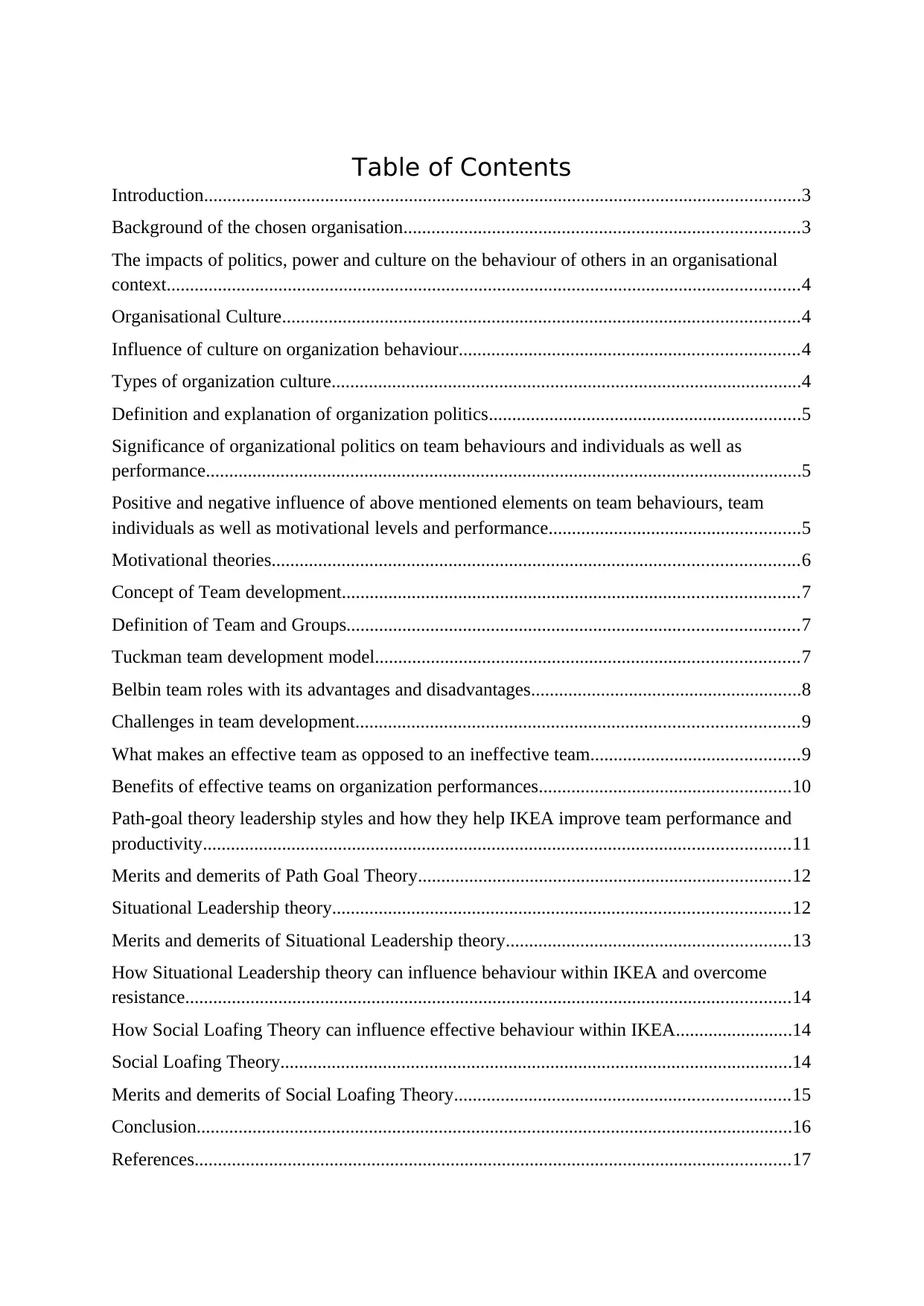
Table of Contents
Introduction................................................................................................................................3
Background of the chosen organisation.....................................................................................3
The impacts of politics, power and culture on the behaviour of others in an organisational
context........................................................................................................................................4
Organisational Culture...............................................................................................................4
Influence of culture on organization behaviour.........................................................................4
Types of organization culture.....................................................................................................4
Definition and explanation of organization politics...................................................................5
Significance of organizational politics on team behaviours and individuals as well as
performance................................................................................................................................5
Positive and negative influence of above mentioned elements on team behaviours, team
individuals as well as motivational levels and performance......................................................5
Motivational theories.................................................................................................................6
Concept of Team development..................................................................................................7
Definition of Team and Groups.................................................................................................7
Tuckman team development model...........................................................................................7
Belbin team roles with its advantages and disadvantages..........................................................8
Challenges in team development...............................................................................................9
What makes an effective team as opposed to an ineffective team.............................................9
Benefits of effective teams on organization performances......................................................10
Path-goal theory leadership styles and how they help IKEA improve team performance and
productivity..............................................................................................................................11
Merits and demerits of Path Goal Theory................................................................................12
Situational Leadership theory..................................................................................................12
Merits and demerits of Situational Leadership theory.............................................................13
How Situational Leadership theory can influence behaviour within IKEA and overcome
resistance..................................................................................................................................14
How Social Loafing Theory can influence effective behaviour within IKEA.........................14
Social Loafing Theory..............................................................................................................14
Merits and demerits of Social Loafing Theory........................................................................15
Conclusion................................................................................................................................16
References................................................................................................................................17
Introduction................................................................................................................................3
Background of the chosen organisation.....................................................................................3
The impacts of politics, power and culture on the behaviour of others in an organisational
context........................................................................................................................................4
Organisational Culture...............................................................................................................4
Influence of culture on organization behaviour.........................................................................4
Types of organization culture.....................................................................................................4
Definition and explanation of organization politics...................................................................5
Significance of organizational politics on team behaviours and individuals as well as
performance................................................................................................................................5
Positive and negative influence of above mentioned elements on team behaviours, team
individuals as well as motivational levels and performance......................................................5
Motivational theories.................................................................................................................6
Concept of Team development..................................................................................................7
Definition of Team and Groups.................................................................................................7
Tuckman team development model...........................................................................................7
Belbin team roles with its advantages and disadvantages..........................................................8
Challenges in team development...............................................................................................9
What makes an effective team as opposed to an ineffective team.............................................9
Benefits of effective teams on organization performances......................................................10
Path-goal theory leadership styles and how they help IKEA improve team performance and
productivity..............................................................................................................................11
Merits and demerits of Path Goal Theory................................................................................12
Situational Leadership theory..................................................................................................12
Merits and demerits of Situational Leadership theory.............................................................13
How Situational Leadership theory can influence behaviour within IKEA and overcome
resistance..................................................................................................................................14
How Social Loafing Theory can influence effective behaviour within IKEA.........................14
Social Loafing Theory..............................................................................................................14
Merits and demerits of Social Loafing Theory........................................................................15
Conclusion................................................................................................................................16
References................................................................................................................................17
Secure Best Marks with AI Grader
Need help grading? Try our AI Grader for instant feedback on your assignments.
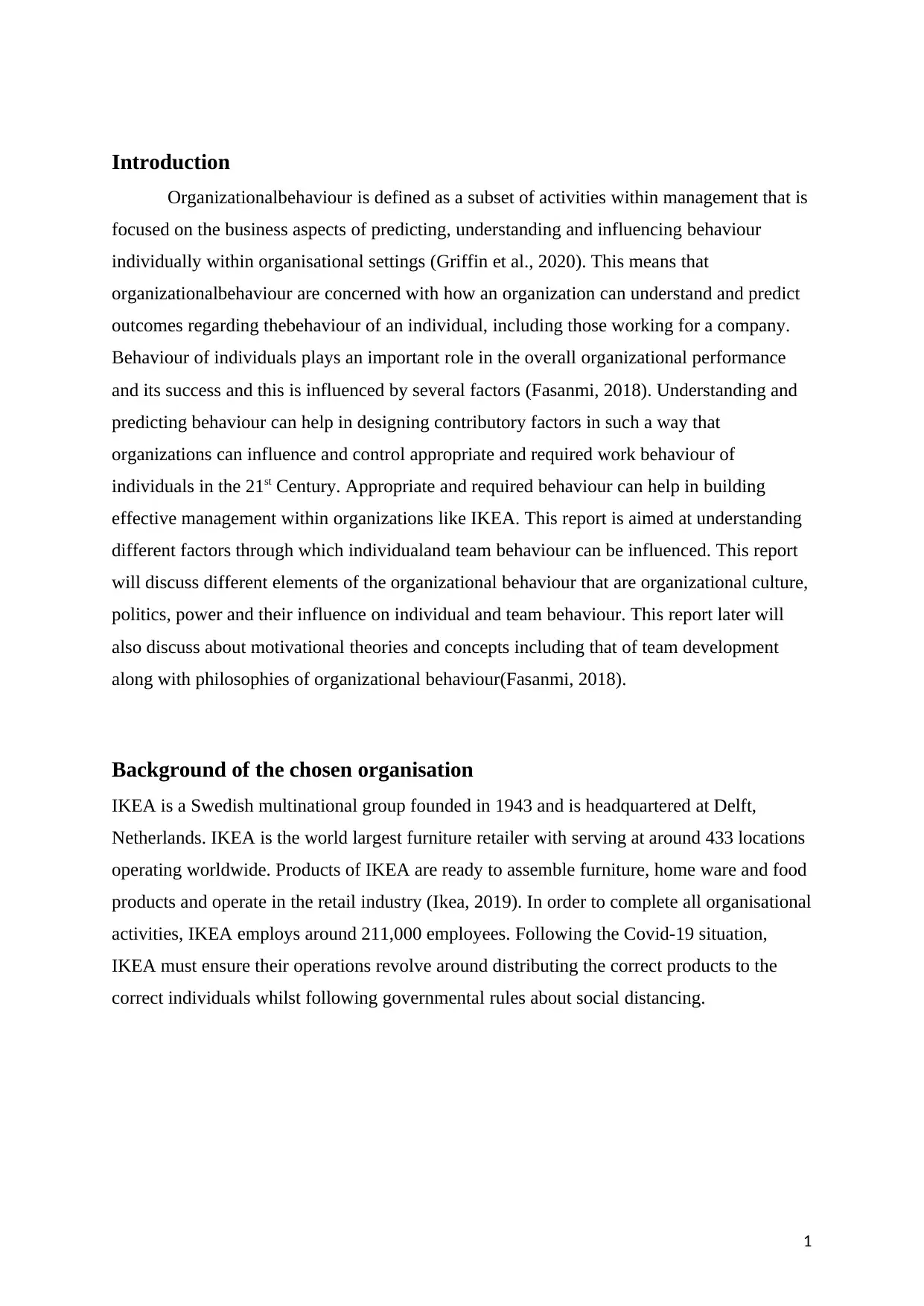
Introduction
Organizationalbehaviour is defined as a subset of activities within management that is
focused on the business aspects of predicting, understanding and influencing behaviour
individually within organisational settings (Griffin et al., 2020). This means that
organizationalbehaviour are concerned with how an organization can understand and predict
outcomes regarding thebehaviour of an individual, including those working for a company.
Behaviour of individuals plays an important role in the overall organizational performance
and its success and this is influenced by several factors (Fasanmi, 2018). Understanding and
predicting behaviour can help in designing contributory factors in such a way that
organizations can influence and control appropriate and required work behaviour of
individuals in the 21st Century. Appropriate and required behaviour can help in building
effective management within organizations like IKEA. This report is aimed at understanding
different factors through which individualand team behaviour can be influenced. This report
will discuss different elements of the organizational behaviour that are organizational culture,
politics, power and their influence on individual and team behaviour. This report later will
also discuss about motivational theories and concepts including that of team development
along with philosophies of organizational behaviour(Fasanmi, 2018).
Background of the chosen organisation
IKEA is a Swedish multinational group founded in 1943 and is headquartered at Delft,
Netherlands. IKEA is the world largest furniture retailer with serving at around 433 locations
operating worldwide. Products of IKEA are ready to assemble furniture, home ware and food
products and operate in the retail industry (Ikea, 2019). In order to complete all organisational
activities, IKEA employs around 211,000 employees. Following the Covid-19 situation,
IKEA must ensure their operations revolve around distributing the correct products to the
correct individuals whilst following governmental rules about social distancing.
1
Organizationalbehaviour is defined as a subset of activities within management that is
focused on the business aspects of predicting, understanding and influencing behaviour
individually within organisational settings (Griffin et al., 2020). This means that
organizationalbehaviour are concerned with how an organization can understand and predict
outcomes regarding thebehaviour of an individual, including those working for a company.
Behaviour of individuals plays an important role in the overall organizational performance
and its success and this is influenced by several factors (Fasanmi, 2018). Understanding and
predicting behaviour can help in designing contributory factors in such a way that
organizations can influence and control appropriate and required work behaviour of
individuals in the 21st Century. Appropriate and required behaviour can help in building
effective management within organizations like IKEA. This report is aimed at understanding
different factors through which individualand team behaviour can be influenced. This report
will discuss different elements of the organizational behaviour that are organizational culture,
politics, power and their influence on individual and team behaviour. This report later will
also discuss about motivational theories and concepts including that of team development
along with philosophies of organizational behaviour(Fasanmi, 2018).
Background of the chosen organisation
IKEA is a Swedish multinational group founded in 1943 and is headquartered at Delft,
Netherlands. IKEA is the world largest furniture retailer with serving at around 433 locations
operating worldwide. Products of IKEA are ready to assemble furniture, home ware and food
products and operate in the retail industry (Ikea, 2019). In order to complete all organisational
activities, IKEA employs around 211,000 employees. Following the Covid-19 situation,
IKEA must ensure their operations revolve around distributing the correct products to the
correct individuals whilst following governmental rules about social distancing.
1

The impacts of politics, power and culture on the behaviour of others in an
organisational context
Organisational Culture
Organisational culture has been defined as a system of shared attitudes and beliefs that
develop within an organisation and guides the behaviour of employees. On the basis of this
definition, organisational behaviour can be considered as beliefs and attitudes of
organisations that are shared with every member of that organisation (Laforet, 2016). These
beliefs and values also influence and impact behaviour of individuals and teams working
within organisations. IKEA has an organisational culture that is based on the spirit of
togetherness, enthusiasm and fun. This is one of the important elements of organisational
culture in IKEA. Other than this culture, IKEA involve values such as togetherness,
acceptance and delegate responsibility and leadership by example.
Influence of culture on organization behaviour
Culture of organizations have significant impact on its behaviour, this means that different
types of culture require expectations and accept different behaviours in organizations
(Laforet, 2016). In relation with IKEA, its culture requires a behaviour that is based on team
work, meaning that team behaviour of individuals should be adequate and individuals of
teams in IKEA also requires to be cost conscious in their approach of working. This is how
organisational culture influences behaviour of individuals in organisations.
Types of organization culture
There are different types of cultures that organizations can obtain like:
Clan Culture
This is the culture in which employees and members are focused and are highly
collaborative in the working environment in which every individual is valued and
communication remains important.
The Positive influence of this culture is that it boosts rates of employee engagement
Negative influence of this is that possibility of conflicts is higher as everyone is part
of the team (Mousa, Massoud. and Ayoubi, 2020).
Adhocracy Culture
This culture is based on innovation and this culture value individuality and employees
are encouraged to think creatively and bring new ideas for the company.
2
organisational context
Organisational Culture
Organisational culture has been defined as a system of shared attitudes and beliefs that
develop within an organisation and guides the behaviour of employees. On the basis of this
definition, organisational behaviour can be considered as beliefs and attitudes of
organisations that are shared with every member of that organisation (Laforet, 2016). These
beliefs and values also influence and impact behaviour of individuals and teams working
within organisations. IKEA has an organisational culture that is based on the spirit of
togetherness, enthusiasm and fun. This is one of the important elements of organisational
culture in IKEA. Other than this culture, IKEA involve values such as togetherness,
acceptance and delegate responsibility and leadership by example.
Influence of culture on organization behaviour
Culture of organizations have significant impact on its behaviour, this means that different
types of culture require expectations and accept different behaviours in organizations
(Laforet, 2016). In relation with IKEA, its culture requires a behaviour that is based on team
work, meaning that team behaviour of individuals should be adequate and individuals of
teams in IKEA also requires to be cost conscious in their approach of working. This is how
organisational culture influences behaviour of individuals in organisations.
Types of organization culture
There are different types of cultures that organizations can obtain like:
Clan Culture
This is the culture in which employees and members are focused and are highly
collaborative in the working environment in which every individual is valued and
communication remains important.
The Positive influence of this culture is that it boosts rates of employee engagement
Negative influence of this is that possibility of conflicts is higher as everyone is part
of the team (Mousa, Massoud. and Ayoubi, 2020).
Adhocracy Culture
This culture is based on innovation and this culture value individuality and employees
are encouraged to think creatively and bring new ideas for the company.
2
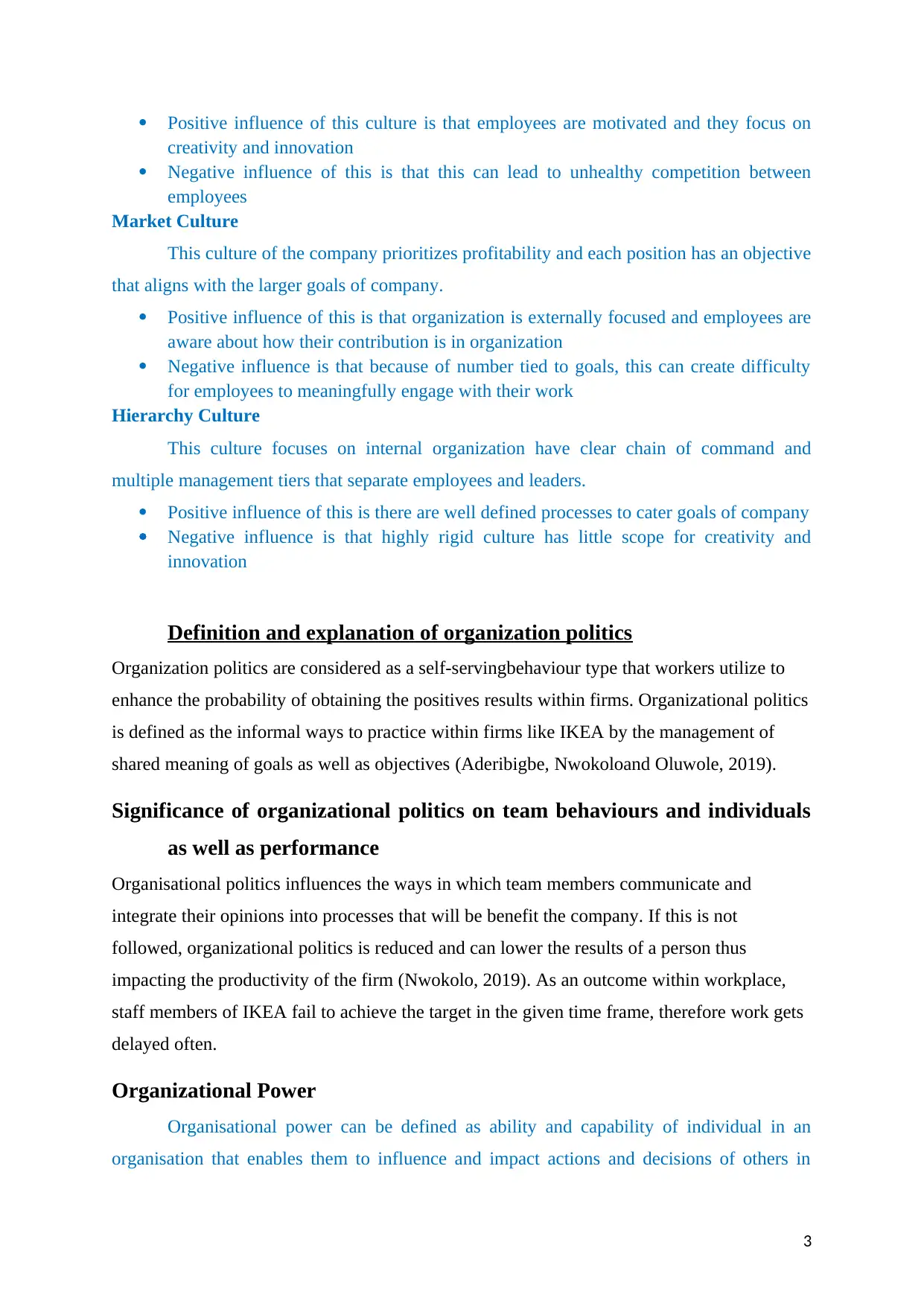
Positive influence of this culture is that employees are motivated and they focus on
creativity and innovation
Negative influence of this is that this can lead to unhealthy competition between
employees
Market Culture
This culture of the company prioritizes profitability and each position has an objective
that aligns with the larger goals of company.
Positive influence of this is that organization is externally focused and employees are
aware about how their contribution is in organization
Negative influence is that because of number tied to goals, this can create difficulty
for employees to meaningfully engage with their work
Hierarchy Culture
This culture focuses on internal organization have clear chain of command and
multiple management tiers that separate employees and leaders.
Positive influence of this is there are well defined processes to cater goals of company
Negative influence is that highly rigid culture has little scope for creativity and
innovation
Definition and explanation of organization politics
Organization politics are considered as a self-servingbehaviour type that workers utilize to
enhance the probability of obtaining the positives results within firms. Organizational politics
is defined as the informal ways to practice within firms like IKEA by the management of
shared meaning of goals as well as objectives (Aderibigbe, Nwokoloand Oluwole, 2019).
Significance of organizational politics on team behaviours and individuals
as well as performance
Organisational politics influences the ways in which team members communicate and
integrate their opinions into processes that will be benefit the company. If this is not
followed, organizational politics is reduced and can lower the results of a person thus
impacting the productivity of the firm (Nwokolo, 2019). As an outcome within workplace,
staff members of IKEA fail to achieve the target in the given time frame, therefore work gets
delayed often.
Organizational Power
Organisational power can be defined as ability and capability of individual in an
organisation that enables them to influence and impact actions and decisions of others in
3
creativity and innovation
Negative influence of this is that this can lead to unhealthy competition between
employees
Market Culture
This culture of the company prioritizes profitability and each position has an objective
that aligns with the larger goals of company.
Positive influence of this is that organization is externally focused and employees are
aware about how their contribution is in organization
Negative influence is that because of number tied to goals, this can create difficulty
for employees to meaningfully engage with their work
Hierarchy Culture
This culture focuses on internal organization have clear chain of command and
multiple management tiers that separate employees and leaders.
Positive influence of this is there are well defined processes to cater goals of company
Negative influence is that highly rigid culture has little scope for creativity and
innovation
Definition and explanation of organization politics
Organization politics are considered as a self-servingbehaviour type that workers utilize to
enhance the probability of obtaining the positives results within firms. Organizational politics
is defined as the informal ways to practice within firms like IKEA by the management of
shared meaning of goals as well as objectives (Aderibigbe, Nwokoloand Oluwole, 2019).
Significance of organizational politics on team behaviours and individuals
as well as performance
Organisational politics influences the ways in which team members communicate and
integrate their opinions into processes that will be benefit the company. If this is not
followed, organizational politics is reduced and can lower the results of a person thus
impacting the productivity of the firm (Nwokolo, 2019). As an outcome within workplace,
staff members of IKEA fail to achieve the target in the given time frame, therefore work gets
delayed often.
Organizational Power
Organisational power can be defined as ability and capability of individual in an
organisation that enables them to influence and impact actions and decisions of others in
3
Secure Best Marks with AI Grader
Need help grading? Try our AI Grader for instant feedback on your assignments.
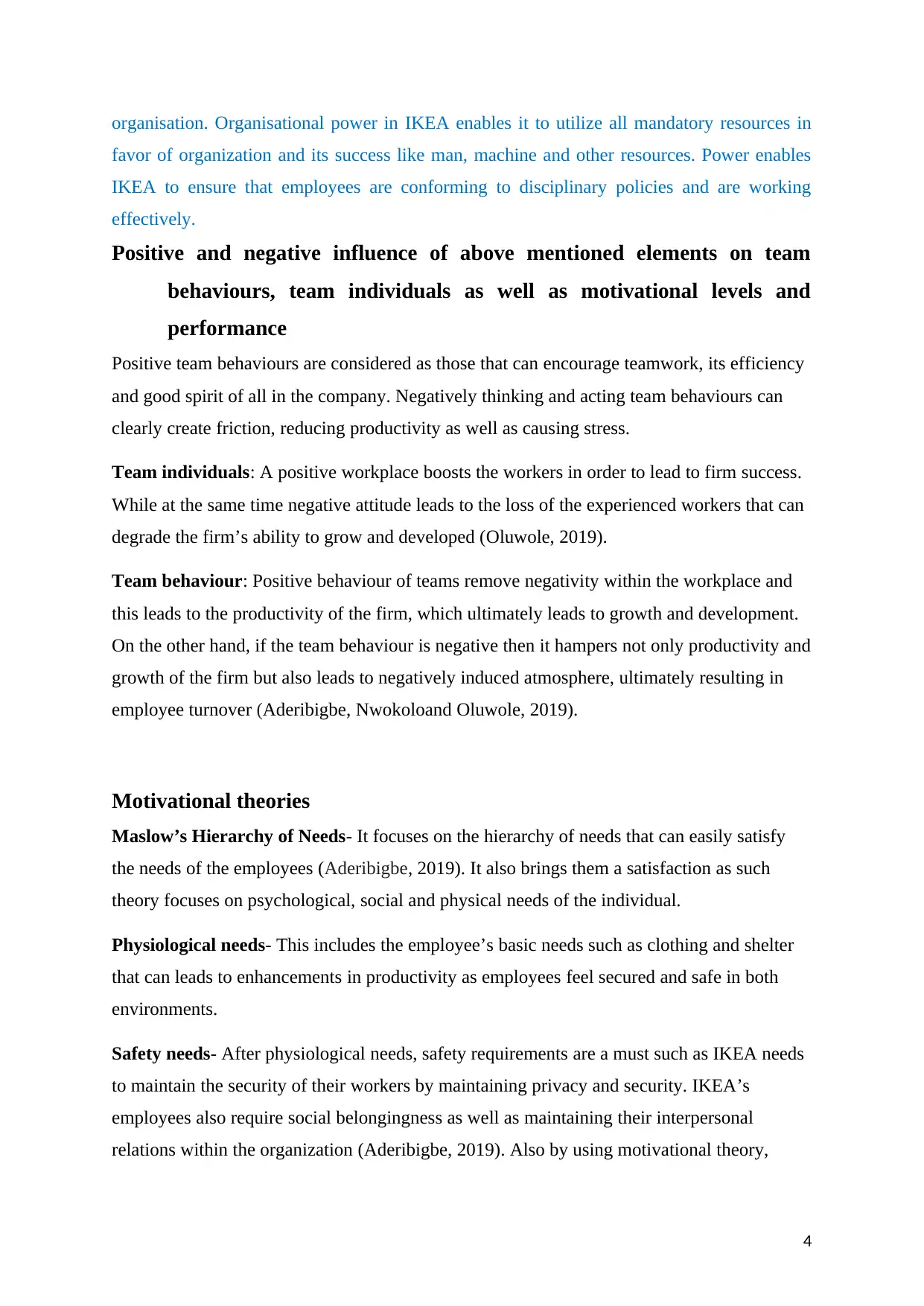
organisation. Organisational power in IKEA enables it to utilize all mandatory resources in
favor of organization and its success like man, machine and other resources. Power enables
IKEA to ensure that employees are conforming to disciplinary policies and are working
effectively.
Positive and negative influence of above mentioned elements on team
behaviours, team individuals as well as motivational levels and
performance
Positive team behaviours are considered as those that can encourage teamwork, its efficiency
and good spirit of all in the company. Negatively thinking and acting team behaviours can
clearly create friction, reducing productivity as well as causing stress.
Team individuals: A positive workplace boosts the workers in order to lead to firm success.
While at the same time negative attitude leads to the loss of the experienced workers that can
degrade the firm’s ability to grow and developed (Oluwole, 2019).
Team behaviour: Positive behaviour of teams remove negativity within the workplace and
this leads to the productivity of the firm, which ultimately leads to growth and development.
On the other hand, if the team behaviour is negative then it hampers not only productivity and
growth of the firm but also leads to negatively induced atmosphere, ultimately resulting in
employee turnover (Aderibigbe, Nwokoloand Oluwole, 2019).
Motivational theories
Maslow’s Hierarchy of Needs- It focuses on the hierarchy of needs that can easily satisfy
the needs of the employees (Aderibigbe, 2019). It also brings them a satisfaction as such
theory focuses on psychological, social and physical needs of the individual.
Physiological needs- This includes the employee’s basic needs such as clothing and shelter
that can leads to enhancements in productivity as employees feel secured and safe in both
environments.
Safety needs- After physiological needs, safety requirements are a must such as IKEA needs
to maintain the security of their workers by maintaining privacy and security. IKEA’s
employees also require social belongingness as well as maintaining their interpersonal
relations within the organization (Aderibigbe, 2019). Also by using motivational theory,
4
favor of organization and its success like man, machine and other resources. Power enables
IKEA to ensure that employees are conforming to disciplinary policies and are working
effectively.
Positive and negative influence of above mentioned elements on team
behaviours, team individuals as well as motivational levels and
performance
Positive team behaviours are considered as those that can encourage teamwork, its efficiency
and good spirit of all in the company. Negatively thinking and acting team behaviours can
clearly create friction, reducing productivity as well as causing stress.
Team individuals: A positive workplace boosts the workers in order to lead to firm success.
While at the same time negative attitude leads to the loss of the experienced workers that can
degrade the firm’s ability to grow and developed (Oluwole, 2019).
Team behaviour: Positive behaviour of teams remove negativity within the workplace and
this leads to the productivity of the firm, which ultimately leads to growth and development.
On the other hand, if the team behaviour is negative then it hampers not only productivity and
growth of the firm but also leads to negatively induced atmosphere, ultimately resulting in
employee turnover (Aderibigbe, Nwokoloand Oluwole, 2019).
Motivational theories
Maslow’s Hierarchy of Needs- It focuses on the hierarchy of needs that can easily satisfy
the needs of the employees (Aderibigbe, 2019). It also brings them a satisfaction as such
theory focuses on psychological, social and physical needs of the individual.
Physiological needs- This includes the employee’s basic needs such as clothing and shelter
that can leads to enhancements in productivity as employees feel secured and safe in both
environments.
Safety needs- After physiological needs, safety requirements are a must such as IKEA needs
to maintain the security of their workers by maintaining privacy and security. IKEA’s
employees also require social belongingness as well as maintaining their interpersonal
relations within the organization (Aderibigbe, 2019). Also by using motivational theory,
4

IKEA must continue to appreciate their employees within the workplace and also give
rewards regarding on the basis of performance.
Self-esteem needs- self esteem needs is concerned with need in which individual wants to get
recognized by peers and organizational members. This also known as desire for reputation
and respect from others and esteem for dignity.
Self actualization needs- This is a need in which individual has desire and need for
realization of potential, self-fulfillment and seeking personal growth and experiences.
Advantages and disadvantages of Hierarchy of needs
One of the advantages of this theory is that it can motivate employees of IKEA to move from
fundamental requirements to the higher requirements as it also gives a clear map regarding
personal growth. In contrast to this, it also fails to describe why various individuals prefer to
ignore lesser requirements within search of the higher ones (Aderibigbe, Nwokolo and
Oluwole, 2019).
IKEA can use Maslow’s hierarchy of needs in an effective way. In order to utilize IKEA
needs to analyze needs of employees at level in organization. This is because these needs are
significantly linked with position and level at which they work. Lower level position has
lower needs and higher level positions have higher level needs and this is why identification
of these needs will help IKEA in utilization of theory of reduce turnover of employees by
ensuring that they are motivated.
Vroom expectancy theory- This theory refers to the focus ofbehaviour within terms of
products that are available for prioritized. It is relied on the idea that staff member’s
satisfaction can minimize the dissatisfaction.
Expectancy- This is concerned with the belief that extra efforts will lead to improved
performance of employees. IKEA requires communicating efforts required for achieving
desired results.
Instrumentality- This is belief that improved performance of employees will lead to
attainment of objectives and desired rewards.
Valence- This is the value that employees give to their desired results. High value and
importance given will motivate employees to work effectively and get desired results.
IKEA must consider the Vroom expectancy theory as well as it recognizes the employee’s
skills, personality and knowledge within the firm (Nwokolo, 2019). By the help of this
theory, IKEA can analysis the performance of their workers and at the same time motivate
5
rewards regarding on the basis of performance.
Self-esteem needs- self esteem needs is concerned with need in which individual wants to get
recognized by peers and organizational members. This also known as desire for reputation
and respect from others and esteem for dignity.
Self actualization needs- This is a need in which individual has desire and need for
realization of potential, self-fulfillment and seeking personal growth and experiences.
Advantages and disadvantages of Hierarchy of needs
One of the advantages of this theory is that it can motivate employees of IKEA to move from
fundamental requirements to the higher requirements as it also gives a clear map regarding
personal growth. In contrast to this, it also fails to describe why various individuals prefer to
ignore lesser requirements within search of the higher ones (Aderibigbe, Nwokolo and
Oluwole, 2019).
IKEA can use Maslow’s hierarchy of needs in an effective way. In order to utilize IKEA
needs to analyze needs of employees at level in organization. This is because these needs are
significantly linked with position and level at which they work. Lower level position has
lower needs and higher level positions have higher level needs and this is why identification
of these needs will help IKEA in utilization of theory of reduce turnover of employees by
ensuring that they are motivated.
Vroom expectancy theory- This theory refers to the focus ofbehaviour within terms of
products that are available for prioritized. It is relied on the idea that staff member’s
satisfaction can minimize the dissatisfaction.
Expectancy- This is concerned with the belief that extra efforts will lead to improved
performance of employees. IKEA requires communicating efforts required for achieving
desired results.
Instrumentality- This is belief that improved performance of employees will lead to
attainment of objectives and desired rewards.
Valence- This is the value that employees give to their desired results. High value and
importance given will motivate employees to work effectively and get desired results.
IKEA must consider the Vroom expectancy theory as well as it recognizes the employee’s
skills, personality and knowledge within the firm (Nwokolo, 2019). By the help of this
theory, IKEA can analysis the performance of their workers and at the same time motivate
5

them to put efforts into their work in order to achieve the aims and goals. While on the other
hand, it also provides an effective training system for their workers in order to improve
knowledge as well as skills long term.
Advantages of this theory are that expectations of the employee are encouraged through
rewards as well as incentives. By providing appropriate goals, this can easily trigger
motivational processes that can help to improve the performance rates. Weaknesses of this
theory is that if the management creating motivations as well as rewards fails, the workers
will no longer uphold the values or beliefs that are necessary for efficient work to be
produced which will contribute to IKEA’s sustained development and growth (Aderibigbe,
Nwokolo. and Oluwole, 2019).
Concept of Team development
Definition of Team and Groups
Teams refer to the coming together of different people to achieve common goals and
objectives. Groups refers to number of people gathered together. There are factors that
contribute to effective team such as using the ideas of team development models to build and
development effective team. Some examples of effective team development models include
Tuckman model and Belbin team roles.
Tuckman team development model
The model consists of 5 stages of developing a team. These are:
Forming- this is the first stage as here teamsare formed but individuals do not know what the
goal is, why it is established and so on. They do not know each other and nothing is clear to
them. Basically, teams are formed to attain common goals.
Storming- in this stage, members communicate with one another asking names, Job profiles
and so on, therefore they become aware about the duties and tasks that need to be done and
what their ultimate goal is. In addition, its resources are allocated as well to them and those
around them, making productivity a more recurrent process (MacKie, 2017).
Norming- here members are aware about each other’s qualities so they start developing
bonds and relationships with one another. In this way they can perform tasks and attain goals
more efficiently. Any disputes thatoccur between them is solved by them by communicating.
So, in IKEA members work with each other.
6
hand, it also provides an effective training system for their workers in order to improve
knowledge as well as skills long term.
Advantages of this theory are that expectations of the employee are encouraged through
rewards as well as incentives. By providing appropriate goals, this can easily trigger
motivational processes that can help to improve the performance rates. Weaknesses of this
theory is that if the management creating motivations as well as rewards fails, the workers
will no longer uphold the values or beliefs that are necessary for efficient work to be
produced which will contribute to IKEA’s sustained development and growth (Aderibigbe,
Nwokolo. and Oluwole, 2019).
Concept of Team development
Definition of Team and Groups
Teams refer to the coming together of different people to achieve common goals and
objectives. Groups refers to number of people gathered together. There are factors that
contribute to effective team such as using the ideas of team development models to build and
development effective team. Some examples of effective team development models include
Tuckman model and Belbin team roles.
Tuckman team development model
The model consists of 5 stages of developing a team. These are:
Forming- this is the first stage as here teamsare formed but individuals do not know what the
goal is, why it is established and so on. They do not know each other and nothing is clear to
them. Basically, teams are formed to attain common goals.
Storming- in this stage, members communicate with one another asking names, Job profiles
and so on, therefore they become aware about the duties and tasks that need to be done and
what their ultimate goal is. In addition, its resources are allocated as well to them and those
around them, making productivity a more recurrent process (MacKie, 2017).
Norming- here members are aware about each other’s qualities so they start developing
bonds and relationships with one another. In this way they can perform tasks and attain goals
more efficiently. Any disputes thatoccur between them is solved by them by communicating.
So, in IKEA members work with each other.
6
Paraphrase This Document
Need a fresh take? Get an instant paraphrase of this document with our AI Paraphraser
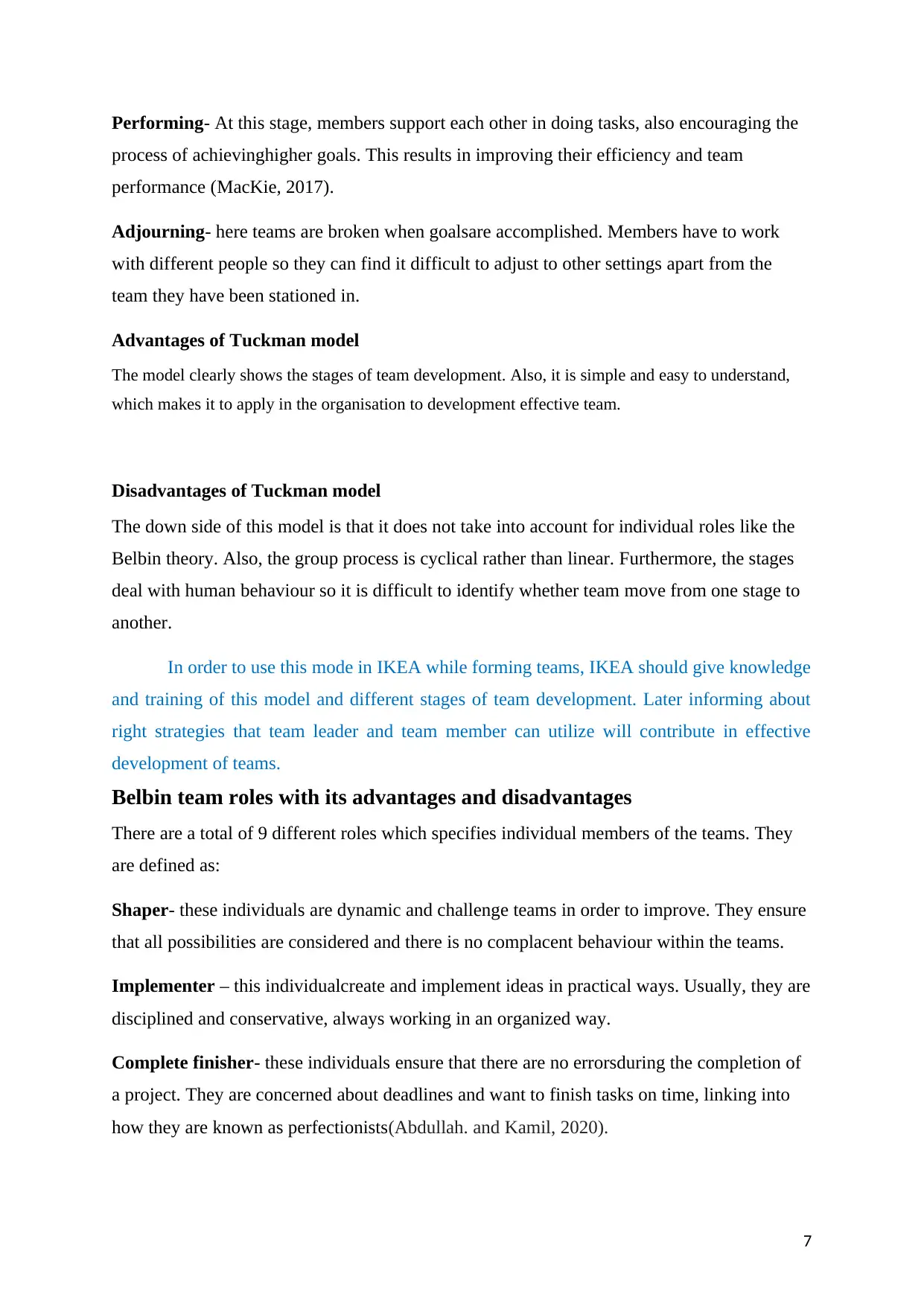
Performing- At this stage, members support each other in doing tasks, also encouraging the
process of achievinghigher goals. This results in improving their efficiency and team
performance (MacKie, 2017).
Adjourning- here teams are broken when goalsare accomplished. Members have to work
with different people so they can find it difficult to adjust to other settings apart from the
team they have been stationed in.
Advantages of Tuckman model
The model clearly shows the stages of team development. Also, it is simple and easy to understand,
which makes it to apply in the organisation to development effective team.
Disadvantages of Tuckman model
The down side of this model is that it does not take into account for individual roles like the
Belbin theory. Also, the group process is cyclical rather than linear. Furthermore, the stages
deal with human behaviour so it is difficult to identify whether team move from one stage to
another.
In order to use this mode in IKEA while forming teams, IKEA should give knowledge
and training of this model and different stages of team development. Later informing about
right strategies that team leader and team member can utilize will contribute in effective
development of teams.
Belbin team roles with its advantages and disadvantages
There are a total of 9 different roles which specifies individual members of the teams. They
are defined as:
Shaper- these individuals are dynamic and challenge teams in order to improve. They ensure
that all possibilities are considered and there is no complacent behaviour within the teams.
Implementer – this individualcreate and implement ideas in practical ways. Usually, they are
disciplined and conservative, always working in an organized way.
Complete finisher- these individuals ensure that there are no errorsduring the completion of
a project. They are concerned about deadlines and want to finish tasks on time, linking into
how they are known as perfectionists(Abdullah. and Kamil, 2020).
7
process of achievinghigher goals. This results in improving their efficiency and team
performance (MacKie, 2017).
Adjourning- here teams are broken when goalsare accomplished. Members have to work
with different people so they can find it difficult to adjust to other settings apart from the
team they have been stationed in.
Advantages of Tuckman model
The model clearly shows the stages of team development. Also, it is simple and easy to understand,
which makes it to apply in the organisation to development effective team.
Disadvantages of Tuckman model
The down side of this model is that it does not take into account for individual roles like the
Belbin theory. Also, the group process is cyclical rather than linear. Furthermore, the stages
deal with human behaviour so it is difficult to identify whether team move from one stage to
another.
In order to use this mode in IKEA while forming teams, IKEA should give knowledge
and training of this model and different stages of team development. Later informing about
right strategies that team leader and team member can utilize will contribute in effective
development of teams.
Belbin team roles with its advantages and disadvantages
There are a total of 9 different roles which specifies individual members of the teams. They
are defined as:
Shaper- these individuals are dynamic and challenge teams in order to improve. They ensure
that all possibilities are considered and there is no complacent behaviour within the teams.
Implementer – this individualcreate and implement ideas in practical ways. Usually, they are
disciplined and conservative, always working in an organized way.
Complete finisher- these individuals ensure that there are no errorsduring the completion of
a project. They are concerned about deadlines and want to finish tasks on time, linking into
how they are known as perfectionists(Abdullah. and Kamil, 2020).
7
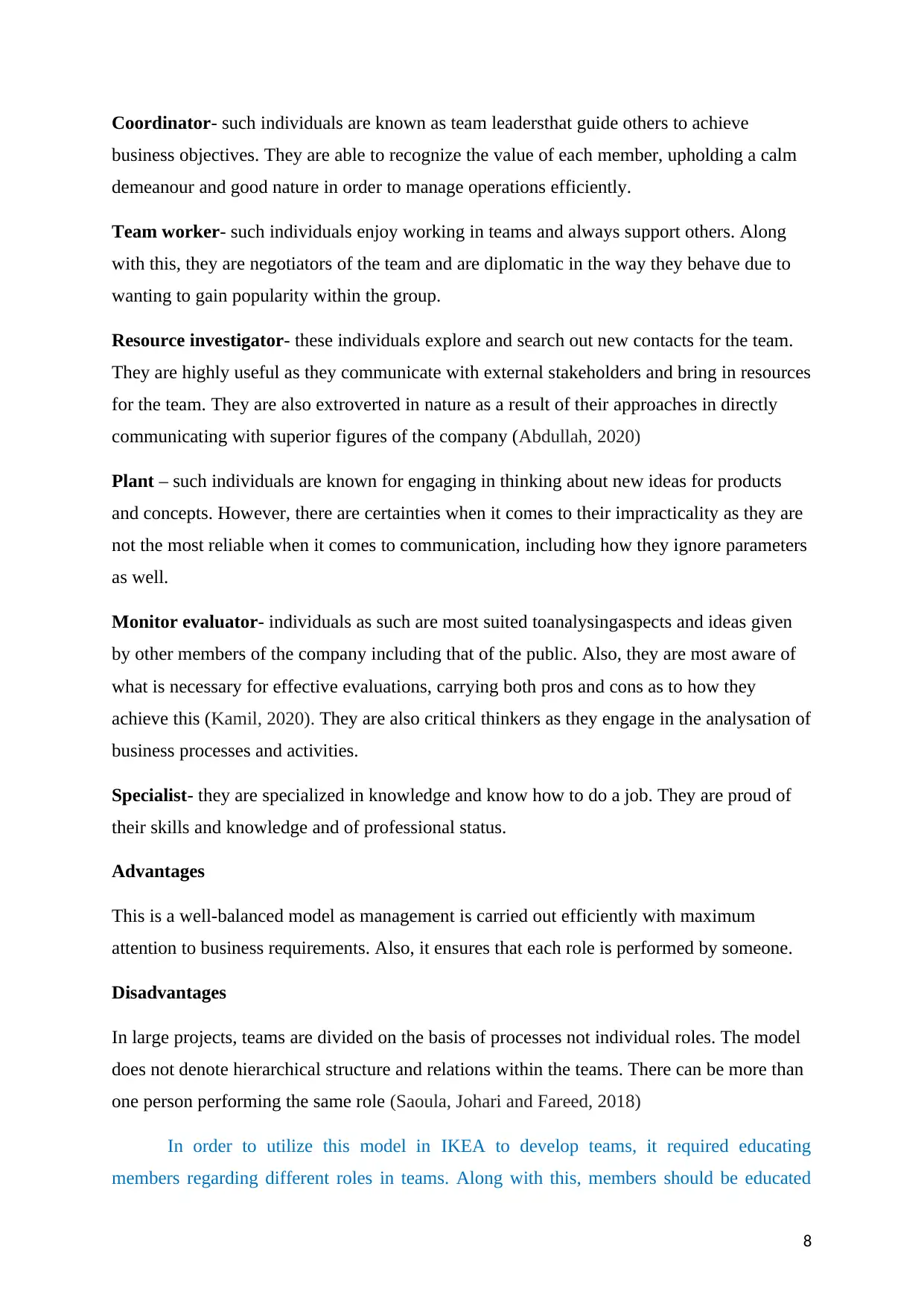
Coordinator- such individuals are known as team leadersthat guide others to achieve
business objectives. They are able to recognize the value of each member, upholding a calm
demeanour and good nature in order to manage operations efficiently.
Team worker- such individuals enjoy working in teams and always support others. Along
with this, they are negotiators of the team and are diplomatic in the way they behave due to
wanting to gain popularity within the group.
Resource investigator- these individuals explore and search out new contacts for the team.
They are highly useful as they communicate with external stakeholders and bring in resources
for the team. They are also extroverted in nature as a result of their approaches in directly
communicating with superior figures of the company (Abdullah, 2020)
Plant – such individuals are known for engaging in thinking about new ideas for products
and concepts. However, there are certainties when it comes to their impracticality as they are
not the most reliable when it comes to communication, including how they ignore parameters
as well.
Monitor evaluator- individuals as such are most suited toanalysingaspects and ideas given
by other members of the company including that of the public. Also, they are most aware of
what is necessary for effective evaluations, carrying both pros and cons as to how they
achieve this (Kamil, 2020). They are also critical thinkers as they engage in the analysation of
business processes and activities.
Specialist- they are specialized in knowledge and know how to do a job. They are proud of
their skills and knowledge and of professional status.
Advantages
This is a well-balanced model as management is carried out efficiently with maximum
attention to business requirements. Also, it ensures that each role is performed by someone.
Disadvantages
In large projects, teams are divided on the basis of processes not individual roles. The model
does not denote hierarchical structure and relations within the teams. There can be more than
one person performing the same role (Saoula, Johari and Fareed, 2018)
In order to utilize this model in IKEA to develop teams, it required educating
members regarding different roles in teams. Along with this, members should be educated
8
business objectives. They are able to recognize the value of each member, upholding a calm
demeanour and good nature in order to manage operations efficiently.
Team worker- such individuals enjoy working in teams and always support others. Along
with this, they are negotiators of the team and are diplomatic in the way they behave due to
wanting to gain popularity within the group.
Resource investigator- these individuals explore and search out new contacts for the team.
They are highly useful as they communicate with external stakeholders and bring in resources
for the team. They are also extroverted in nature as a result of their approaches in directly
communicating with superior figures of the company (Abdullah, 2020)
Plant – such individuals are known for engaging in thinking about new ideas for products
and concepts. However, there are certainties when it comes to their impracticality as they are
not the most reliable when it comes to communication, including how they ignore parameters
as well.
Monitor evaluator- individuals as such are most suited toanalysingaspects and ideas given
by other members of the company including that of the public. Also, they are most aware of
what is necessary for effective evaluations, carrying both pros and cons as to how they
achieve this (Kamil, 2020). They are also critical thinkers as they engage in the analysation of
business processes and activities.
Specialist- they are specialized in knowledge and know how to do a job. They are proud of
their skills and knowledge and of professional status.
Advantages
This is a well-balanced model as management is carried out efficiently with maximum
attention to business requirements. Also, it ensures that each role is performed by someone.
Disadvantages
In large projects, teams are divided on the basis of processes not individual roles. The model
does not denote hierarchical structure and relations within the teams. There can be more than
one person performing the same role (Saoula, Johari and Fareed, 2018)
In order to utilize this model in IKEA to develop teams, it required educating
members regarding different roles in teams. Along with this, members should be educated
8

about how they can identify what role is suitable for them and or what role they can work on
best. This will help employees in understanding their role and they can work on to develop
their role and work effectively.
Challenges in team development
There are several challenges which team development faces. These include:
Conflicts- this is a common challenge which is faced by all teams. In this case, conflict can
occur regarding assigning roles and selecting specificmembers.
Ineffective teams- this challenge is faced as individuals selected in teams do not have similar
skills and abilities, therefore their capabilities of performing at the same level as compared to
others is lower(MacKie, 2017).
What makes an effective team as opposed to an ineffective team
There are two types of teams available, one being effective and another ineffective. The
difference between the two is that in effective teams, there is a process followed to form it
and roles are assigned on the basis of skills and abilities of each member including how there
is a formal way of communicating. Furthermore, decisions are made by following a protocol
and ensuring that all members agree to it. The leader makes the final decision from which
certain guidelines are followed in order for plans or schemes to be finalised and effectuated.
The performance of members is also measured and regular meetings are conducted as well.
Alongside this, there is a division of labour so all members are aware of their roles and
expected duties, whom they have to report and other aspects that are followed to ensure each
member contributes equallyto the project, whilst providing support for each other when
completing tasks(Simbine and Tukamushaba, 2020).
On the other hand, ineffective teamsare formed in an informal way and remain for short time
periods. There is no set criteria that is followed, resulting in the assignment of roles occurring
inefficiently as there is no proper way of communication between team members. Decisions
are solely made by members on the basis of their interest at the time and without discussing
whether or not this is the most appropriate action to take or if this will negatively affect
another individual within the team. There is no criterion or process that is followed regarding
decision making for work. There is no division of labour, resulting in the lack of systematic
ways of assigning roles with the impression that they will be ultimately completed. In
9
best. This will help employees in understanding their role and they can work on to develop
their role and work effectively.
Challenges in team development
There are several challenges which team development faces. These include:
Conflicts- this is a common challenge which is faced by all teams. In this case, conflict can
occur regarding assigning roles and selecting specificmembers.
Ineffective teams- this challenge is faced as individuals selected in teams do not have similar
skills and abilities, therefore their capabilities of performing at the same level as compared to
others is lower(MacKie, 2017).
What makes an effective team as opposed to an ineffective team
There are two types of teams available, one being effective and another ineffective. The
difference between the two is that in effective teams, there is a process followed to form it
and roles are assigned on the basis of skills and abilities of each member including how there
is a formal way of communicating. Furthermore, decisions are made by following a protocol
and ensuring that all members agree to it. The leader makes the final decision from which
certain guidelines are followed in order for plans or schemes to be finalised and effectuated.
The performance of members is also measured and regular meetings are conducted as well.
Alongside this, there is a division of labour so all members are aware of their roles and
expected duties, whom they have to report and other aspects that are followed to ensure each
member contributes equallyto the project, whilst providing support for each other when
completing tasks(Simbine and Tukamushaba, 2020).
On the other hand, ineffective teamsare formed in an informal way and remain for short time
periods. There is no set criteria that is followed, resulting in the assignment of roles occurring
inefficiently as there is no proper way of communication between team members. Decisions
are solely made by members on the basis of their interest at the time and without discussing
whether or not this is the most appropriate action to take or if this will negatively affect
another individual within the team. There is no criterion or process that is followed regarding
decision making for work. There is no division of labour, resulting in the lack of systematic
ways of assigning roles with the impression that they will be ultimately completed. In
9
Secure Best Marks with AI Grader
Need help grading? Try our AI Grader for instant feedback on your assignments.
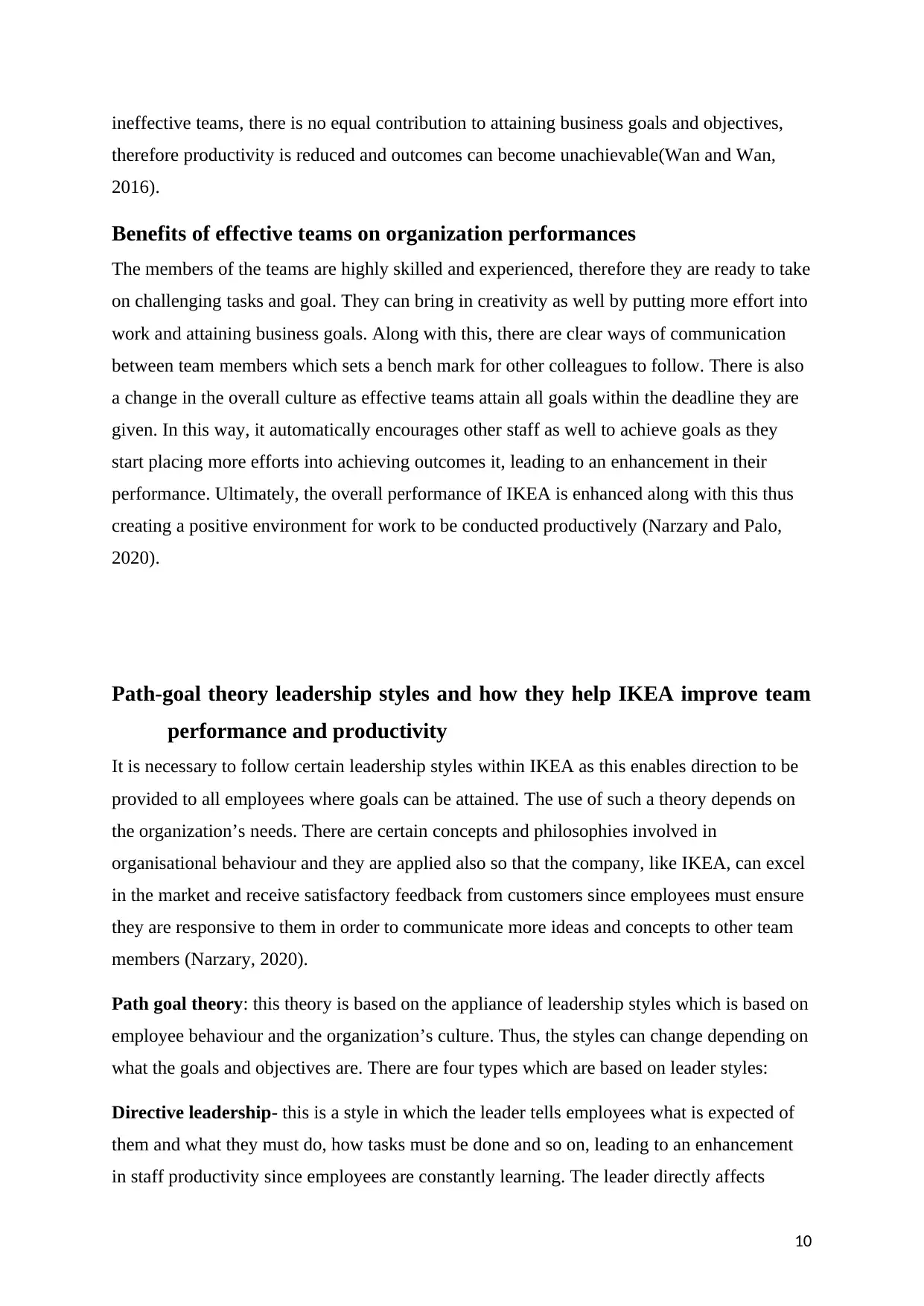
ineffective teams, there is no equal contribution to attaining business goals and objectives,
therefore productivity is reduced and outcomes can become unachievable(Wan and Wan,
2016).
Benefits of effective teams on organization performances
The members of the teams are highly skilled and experienced, therefore they are ready to take
on challenging tasks and goal. They can bring in creativity as well by putting more effort into
work and attaining business goals. Along with this, there are clear ways of communication
between team members which sets a bench mark for other colleagues to follow. There is also
a change in the overall culture as effective teams attain all goals within the deadline they are
given. In this way, it automatically encourages other staff as well to achieve goals as they
start placing more efforts into achieving outcomes it, leading to an enhancement in their
performance. Ultimately, the overall performance of IKEA is enhanced along with this thus
creating a positive environment for work to be conducted productively (Narzary and Palo,
2020).
Path-goal theory leadership styles and how they help IKEA improve team
performance and productivity
It is necessary to follow certain leadership styles within IKEA as this enables direction to be
provided to all employees where goals can be attained. The use of such a theory depends on
the organization’s needs. There are certain concepts and philosophies involved in
organisational behaviour and they are applied also so that the company, like IKEA, can excel
in the market and receive satisfactory feedback from customers since employees must ensure
they are responsive to them in order to communicate more ideas and concepts to other team
members (Narzary, 2020).
Path goal theory: this theory is based on the appliance of leadership styles which is based on
employee behaviour and the organization’s culture. Thus, the styles can change depending on
what the goals and objectives are. There are four types which are based on leader styles:
Directive leadership- this is a style in which the leader tells employees what is expected of
them and what they must do, how tasks must be done and so on, leading to an enhancement
in staff productivity since employees are constantly learning. The leader directly affects
10
therefore productivity is reduced and outcomes can become unachievable(Wan and Wan,
2016).
Benefits of effective teams on organization performances
The members of the teams are highly skilled and experienced, therefore they are ready to take
on challenging tasks and goal. They can bring in creativity as well by putting more effort into
work and attaining business goals. Along with this, there are clear ways of communication
between team members which sets a bench mark for other colleagues to follow. There is also
a change in the overall culture as effective teams attain all goals within the deadline they are
given. In this way, it automatically encourages other staff as well to achieve goals as they
start placing more efforts into achieving outcomes it, leading to an enhancement in their
performance. Ultimately, the overall performance of IKEA is enhanced along with this thus
creating a positive environment for work to be conducted productively (Narzary and Palo,
2020).
Path-goal theory leadership styles and how they help IKEA improve team
performance and productivity
It is necessary to follow certain leadership styles within IKEA as this enables direction to be
provided to all employees where goals can be attained. The use of such a theory depends on
the organization’s needs. There are certain concepts and philosophies involved in
organisational behaviour and they are applied also so that the company, like IKEA, can excel
in the market and receive satisfactory feedback from customers since employees must ensure
they are responsive to them in order to communicate more ideas and concepts to other team
members (Narzary, 2020).
Path goal theory: this theory is based on the appliance of leadership styles which is based on
employee behaviour and the organization’s culture. Thus, the styles can change depending on
what the goals and objectives are. There are four types which are based on leader styles:
Directive leadership- this is a style in which the leader tells employees what is expected of
them and what they must do, how tasks must be done and so on, leading to an enhancement
in staff productivity since employees are constantly learning. The leader directly affects
10
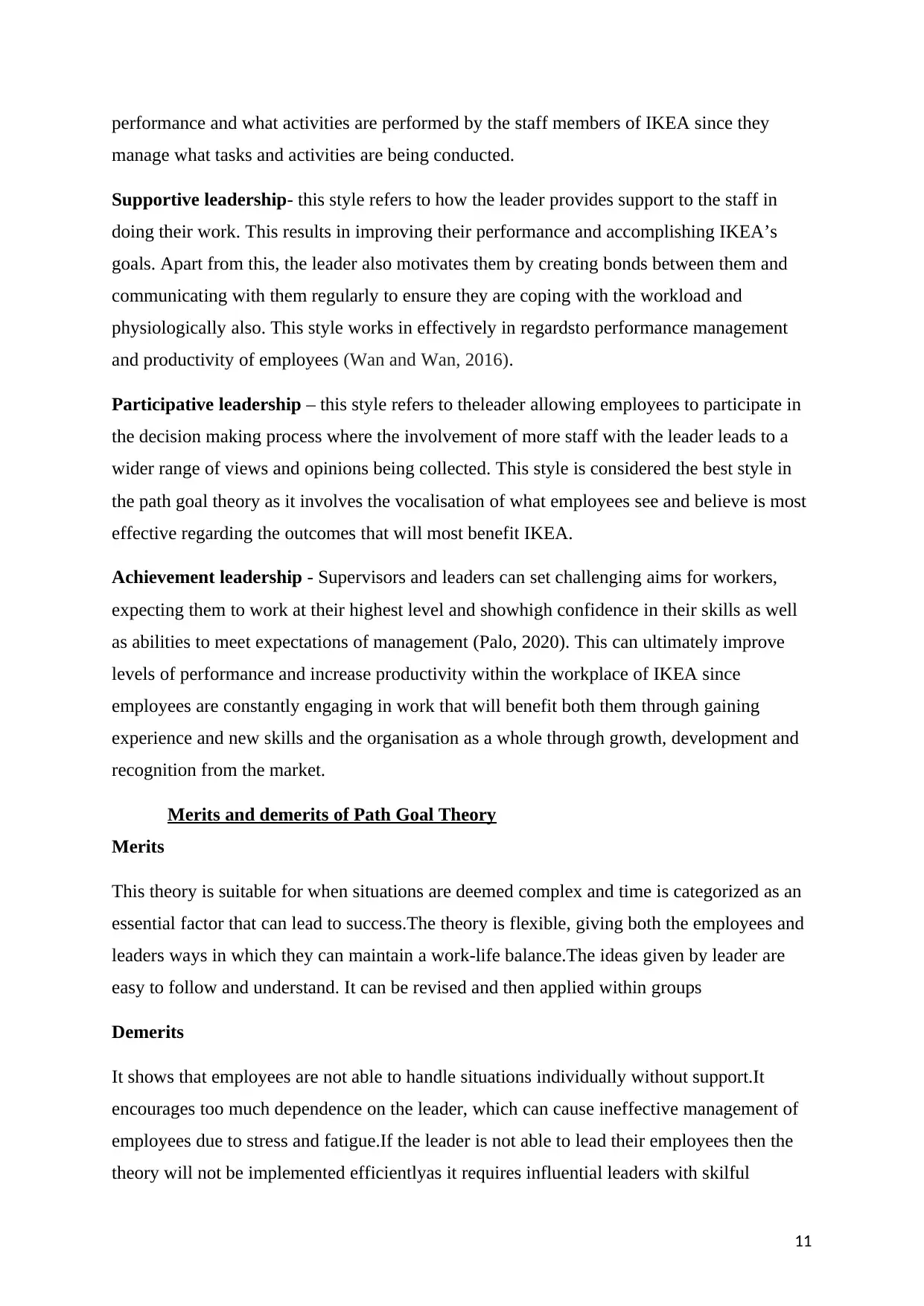
performance and what activities are performed by the staff members of IKEA since they
manage what tasks and activities are being conducted.
Supportive leadership- this style refers to how the leader provides support to the staff in
doing their work. This results in improving their performance and accomplishing IKEA’s
goals. Apart from this, the leader also motivates them by creating bonds between them and
communicating with them regularly to ensure they are coping with the workload and
physiologically also. This style works in effectively in regardsto performance management
and productivity of employees (Wan and Wan, 2016).
Participative leadership – this style refers to theleader allowing employees to participate in
the decision making process where the involvement of more staff with the leader leads to a
wider range of views and opinions being collected. This style is considered the best style in
the path goal theory as it involves the vocalisation of what employees see and believe is most
effective regarding the outcomes that will most benefit IKEA.
Achievement leadership - Supervisors and leaders can set challenging aims for workers,
expecting them to work at their highest level and showhigh confidence in their skills as well
as abilities to meet expectations of management (Palo, 2020). This can ultimately improve
levels of performance and increase productivity within the workplace of IKEA since
employees are constantly engaging in work that will benefit both them through gaining
experience and new skills and the organisation as a whole through growth, development and
recognition from the market.
Merits and demerits of Path Goal Theory
Merits
This theory is suitable for when situations are deemed complex and time is categorized as an
essential factor that can lead to success.The theory is flexible, giving both the employees and
leaders ways in which they can maintain a work-life balance.The ideas given by leader are
easy to follow and understand. It can be revised and then applied within groups
Demerits
It shows that employees are not able to handle situations individually without support.It
encourages too much dependence on the leader, which can cause ineffective management of
employees due to stress and fatigue.If the leader is not able to lead their employees then the
theory will not be implemented efficientlyas it requires influential leaders with skilful
11
manage what tasks and activities are being conducted.
Supportive leadership- this style refers to how the leader provides support to the staff in
doing their work. This results in improving their performance and accomplishing IKEA’s
goals. Apart from this, the leader also motivates them by creating bonds between them and
communicating with them regularly to ensure they are coping with the workload and
physiologically also. This style works in effectively in regardsto performance management
and productivity of employees (Wan and Wan, 2016).
Participative leadership – this style refers to theleader allowing employees to participate in
the decision making process where the involvement of more staff with the leader leads to a
wider range of views and opinions being collected. This style is considered the best style in
the path goal theory as it involves the vocalisation of what employees see and believe is most
effective regarding the outcomes that will most benefit IKEA.
Achievement leadership - Supervisors and leaders can set challenging aims for workers,
expecting them to work at their highest level and showhigh confidence in their skills as well
as abilities to meet expectations of management (Palo, 2020). This can ultimately improve
levels of performance and increase productivity within the workplace of IKEA since
employees are constantly engaging in work that will benefit both them through gaining
experience and new skills and the organisation as a whole through growth, development and
recognition from the market.
Merits and demerits of Path Goal Theory
Merits
This theory is suitable for when situations are deemed complex and time is categorized as an
essential factor that can lead to success.The theory is flexible, giving both the employees and
leaders ways in which they can maintain a work-life balance.The ideas given by leader are
easy to follow and understand. It can be revised and then applied within groups
Demerits
It shows that employees are not able to handle situations individually without support.It
encourages too much dependence on the leader, which can cause ineffective management of
employees due to stress and fatigue.If the leader is not able to lead their employees then the
theory will not be implemented efficientlyas it requires influential leaders with skilful
11
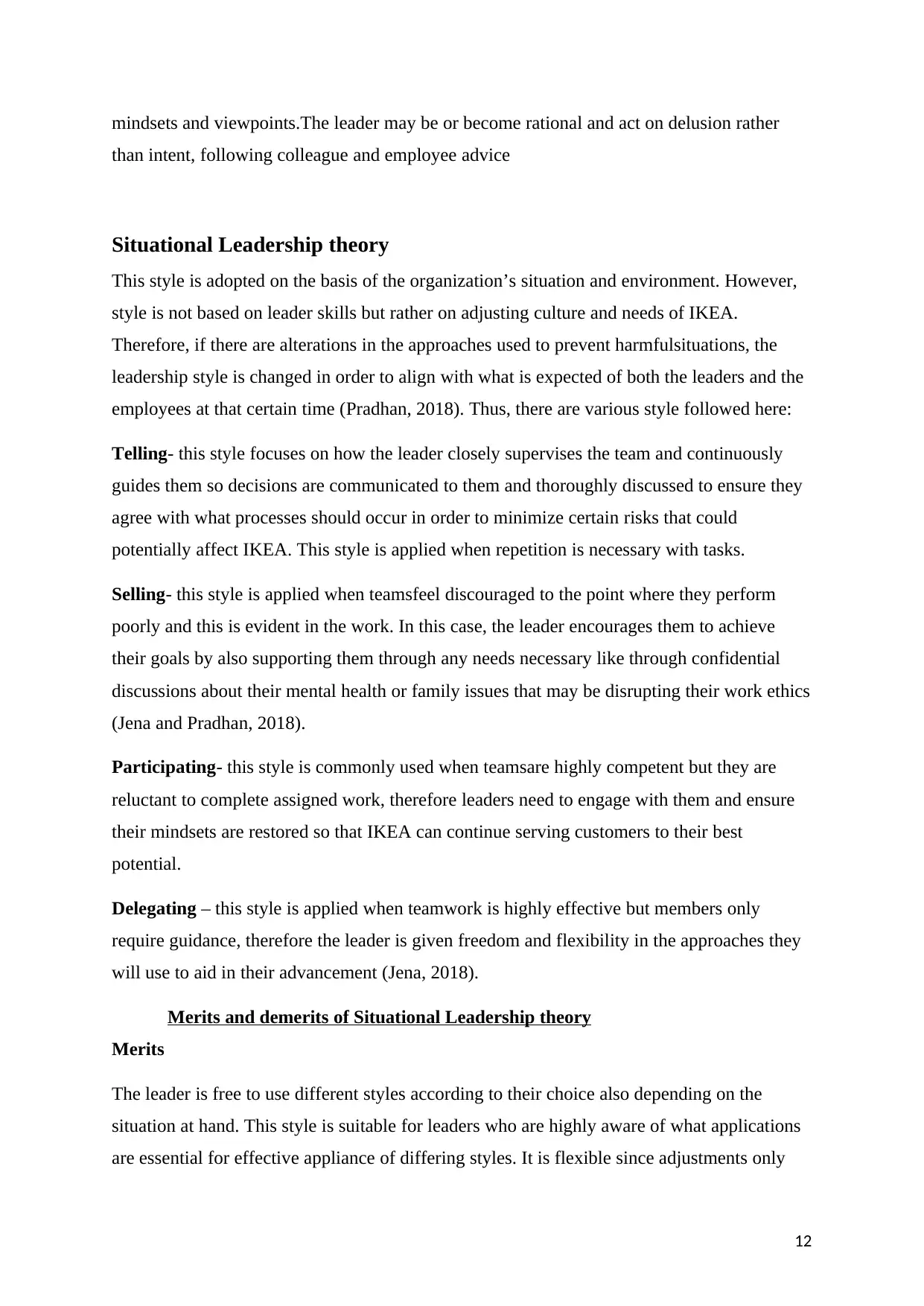
mindsets and viewpoints.The leader may be or become rational and act on delusion rather
than intent, following colleague and employee advice
Situational Leadership theory
This style is adopted on the basis of the organization’s situation and environment. However,
style is not based on leader skills but rather on adjusting culture and needs of IKEA.
Therefore, if there are alterations in the approaches used to prevent harmfulsituations, the
leadership style is changed in order to align with what is expected of both the leaders and the
employees at that certain time (Pradhan, 2018). Thus, there are various style followed here:
Telling- this style focuses on how the leader closely supervises the team and continuously
guides them so decisions are communicated to them and thoroughly discussed to ensure they
agree with what processes should occur in order to minimize certain risks that could
potentially affect IKEA. This style is applied when repetition is necessary with tasks.
Selling- this style is applied when teamsfeel discouraged to the point where they perform
poorly and this is evident in the work. In this case, the leader encourages them to achieve
their goals by also supporting them through any needs necessary like through confidential
discussions about their mental health or family issues that may be disrupting their work ethics
(Jena and Pradhan, 2018).
Participating- this style is commonly used when teamsare highly competent but they are
reluctant to complete assigned work, therefore leaders need to engage with them and ensure
their mindsets are restored so that IKEA can continue serving customers to their best
potential.
Delegating – this style is applied when teamwork is highly effective but members only
require guidance, therefore the leader is given freedom and flexibility in the approaches they
will use to aid in their advancement (Jena, 2018).
Merits and demerits of Situational Leadership theory
Merits
The leader is free to use different styles according to their choice also depending on the
situation at hand. This style is suitable for leaders who are highly aware of what applications
are essential for effective appliance of differing styles. It is flexible since adjustments only
12
than intent, following colleague and employee advice
Situational Leadership theory
This style is adopted on the basis of the organization’s situation and environment. However,
style is not based on leader skills but rather on adjusting culture and needs of IKEA.
Therefore, if there are alterations in the approaches used to prevent harmfulsituations, the
leadership style is changed in order to align with what is expected of both the leaders and the
employees at that certain time (Pradhan, 2018). Thus, there are various style followed here:
Telling- this style focuses on how the leader closely supervises the team and continuously
guides them so decisions are communicated to them and thoroughly discussed to ensure they
agree with what processes should occur in order to minimize certain risks that could
potentially affect IKEA. This style is applied when repetition is necessary with tasks.
Selling- this style is applied when teamsfeel discouraged to the point where they perform
poorly and this is evident in the work. In this case, the leader encourages them to achieve
their goals by also supporting them through any needs necessary like through confidential
discussions about their mental health or family issues that may be disrupting their work ethics
(Jena and Pradhan, 2018).
Participating- this style is commonly used when teamsare highly competent but they are
reluctant to complete assigned work, therefore leaders need to engage with them and ensure
their mindsets are restored so that IKEA can continue serving customers to their best
potential.
Delegating – this style is applied when teamwork is highly effective but members only
require guidance, therefore the leader is given freedom and flexibility in the approaches they
will use to aid in their advancement (Jena, 2018).
Merits and demerits of Situational Leadership theory
Merits
The leader is free to use different styles according to their choice also depending on the
situation at hand. This style is suitable for leaders who are highly aware of what applications
are essential for effective appliance of differing styles. It is flexible since adjustments only
12
Paraphrase This Document
Need a fresh take? Get an instant paraphrase of this document with our AI Paraphraser
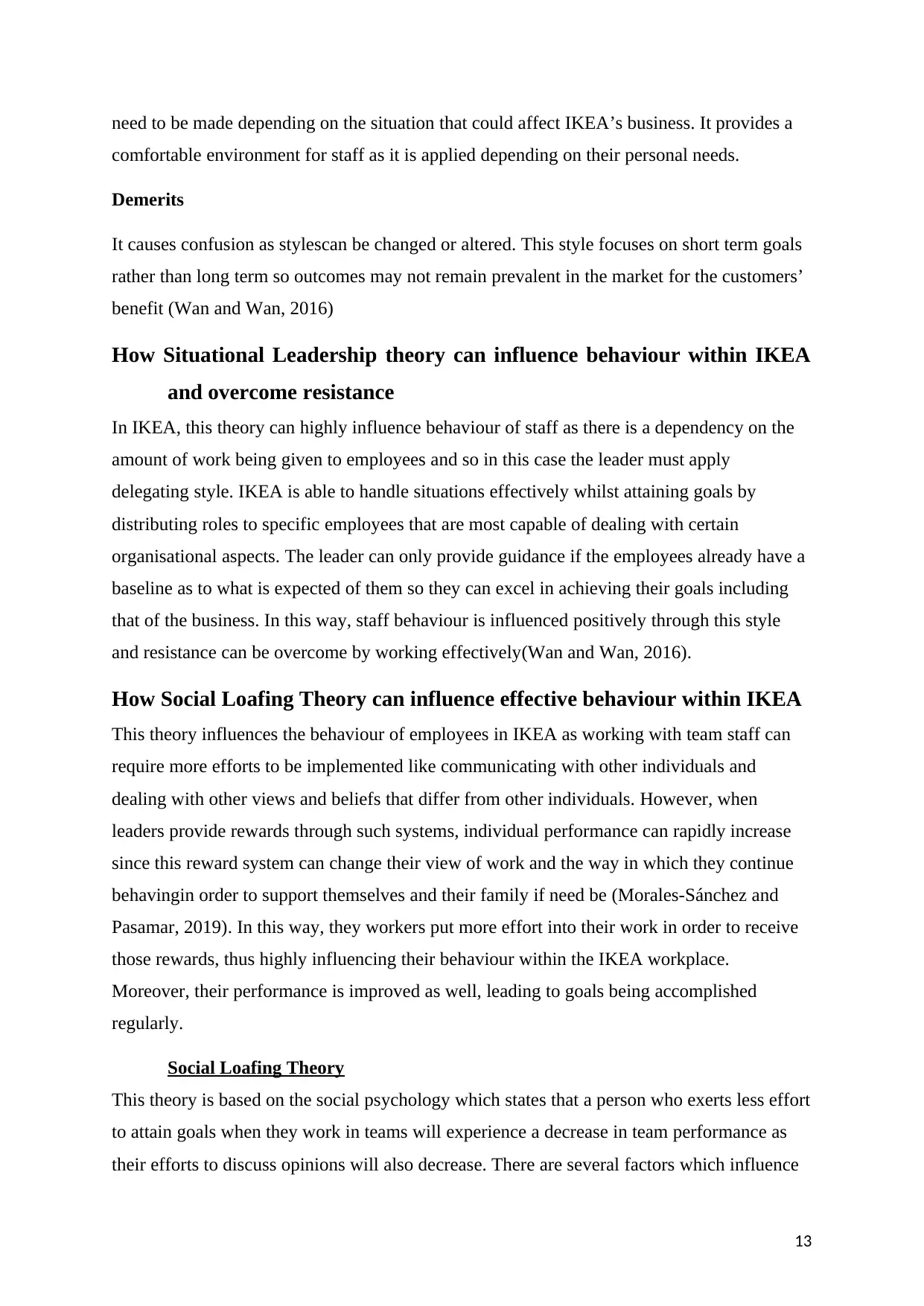
need to be made depending on the situation that could affect IKEA’s business. It provides a
comfortable environment for staff as it is applied depending on their personal needs.
Demerits
It causes confusion as stylescan be changed or altered. This style focuses on short term goals
rather than long term so outcomes may not remain prevalent in the market for the customers’
benefit (Wan and Wan, 2016)
How Situational Leadership theory can influence behaviour within IKEA
and overcome resistance
In IKEA, this theory can highly influence behaviour of staff as there is a dependency on the
amount of work being given to employees and so in this case the leader must apply
delegating style. IKEA is able to handle situations effectively whilst attaining goals by
distributing roles to specific employees that are most capable of dealing with certain
organisational aspects. The leader can only provide guidance if the employees already have a
baseline as to what is expected of them so they can excel in achieving their goals including
that of the business. In this way, staff behaviour is influenced positively through this style
and resistance can be overcome by working effectively(Wan and Wan, 2016).
How Social Loafing Theory can influence effective behaviour within IKEA
This theory influences the behaviour of employees in IKEA as working with team staff can
require more efforts to be implemented like communicating with other individuals and
dealing with other views and beliefs that differ from other individuals. However, when
leaders provide rewards through such systems, individual performance can rapidly increase
since this reward system can change their view of work and the way in which they continue
behavingin order to support themselves and their family if need be (Morales-Sánchez and
Pasamar, 2019). In this way, they workers put more effort into their work in order to receive
those rewards, thus highly influencing their behaviour within the IKEA workplace.
Moreover, their performance is improved as well, leading to goals being accomplished
regularly.
Social Loafing Theory
This theory is based on the social psychology which states that a person who exerts less effort
to attain goals when they work in teams will experience a decrease in team performance as
their efforts to discuss opinions will also decrease. There are several factors which influence
13
comfortable environment for staff as it is applied depending on their personal needs.
Demerits
It causes confusion as stylescan be changed or altered. This style focuses on short term goals
rather than long term so outcomes may not remain prevalent in the market for the customers’
benefit (Wan and Wan, 2016)
How Situational Leadership theory can influence behaviour within IKEA
and overcome resistance
In IKEA, this theory can highly influence behaviour of staff as there is a dependency on the
amount of work being given to employees and so in this case the leader must apply
delegating style. IKEA is able to handle situations effectively whilst attaining goals by
distributing roles to specific employees that are most capable of dealing with certain
organisational aspects. The leader can only provide guidance if the employees already have a
baseline as to what is expected of them so they can excel in achieving their goals including
that of the business. In this way, staff behaviour is influenced positively through this style
and resistance can be overcome by working effectively(Wan and Wan, 2016).
How Social Loafing Theory can influence effective behaviour within IKEA
This theory influences the behaviour of employees in IKEA as working with team staff can
require more efforts to be implemented like communicating with other individuals and
dealing with other views and beliefs that differ from other individuals. However, when
leaders provide rewards through such systems, individual performance can rapidly increase
since this reward system can change their view of work and the way in which they continue
behavingin order to support themselves and their family if need be (Morales-Sánchez and
Pasamar, 2019). In this way, they workers put more effort into their work in order to receive
those rewards, thus highly influencing their behaviour within the IKEA workplace.
Moreover, their performance is improved as well, leading to goals being accomplished
regularly.
Social Loafing Theory
This theory is based on the social psychology which states that a person who exerts less effort
to attain goals when they work in teams will experience a decrease in team performance as
their efforts to discuss opinions will also decrease. There are several factors which influence
13
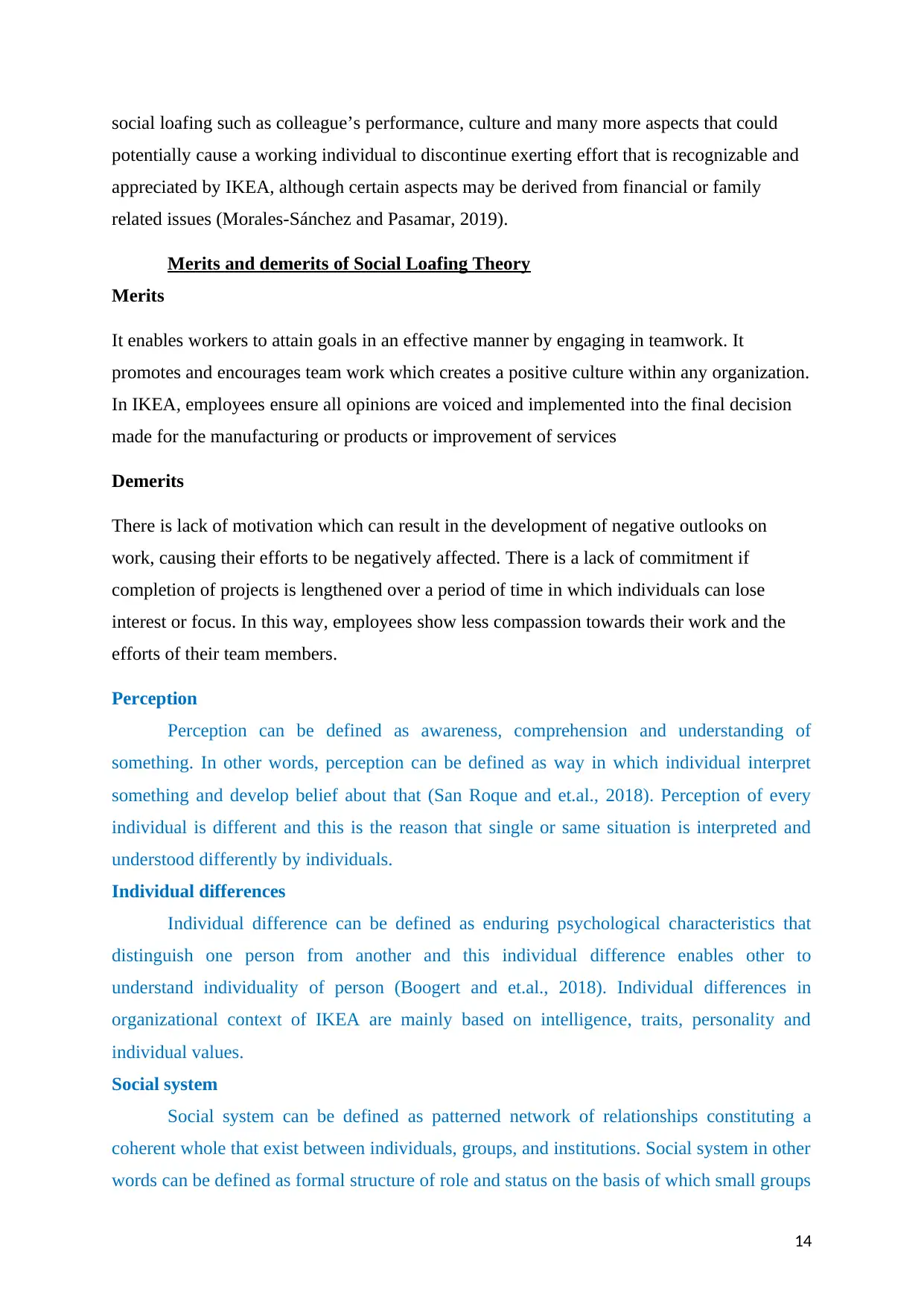
social loafing such as colleague’s performance, culture and many more aspects that could
potentially cause a working individual to discontinue exerting effort that is recognizable and
appreciated by IKEA, although certain aspects may be derived from financial or family
related issues (Morales-Sánchez and Pasamar, 2019).
Merits and demerits of Social Loafing Theory
Merits
It enables workers to attain goals in an effective manner by engaging in teamwork. It
promotes and encourages team work which creates a positive culture within any organization.
In IKEA, employees ensure all opinions are voiced and implemented into the final decision
made for the manufacturing or products or improvement of services
Demerits
There is lack of motivation which can result in the development of negative outlooks on
work, causing their efforts to be negatively affected. There is a lack of commitment if
completion of projects is lengthened over a period of time in which individuals can lose
interest or focus. In this way, employees show less compassion towards their work and the
efforts of their team members.
Perception
Perception can be defined as awareness, comprehension and understanding of
something. In other words, perception can be defined as way in which individual interpret
something and develop belief about that (San Roque and et.al., 2018). Perception of every
individual is different and this is the reason that single or same situation is interpreted and
understood differently by individuals.
Individual differences
Individual difference can be defined as enduring psychological characteristics that
distinguish one person from another and this individual difference enables other to
understand individuality of person (Boogert and et.al., 2018). Individual differences in
organizational context of IKEA are mainly based on intelligence, traits, personality and
individual values.
Social system
Social system can be defined as patterned network of relationships constituting a
coherent whole that exist between individuals, groups, and institutions. Social system in other
words can be defined as formal structure of role and status on the basis of which small groups
14
potentially cause a working individual to discontinue exerting effort that is recognizable and
appreciated by IKEA, although certain aspects may be derived from financial or family
related issues (Morales-Sánchez and Pasamar, 2019).
Merits and demerits of Social Loafing Theory
Merits
It enables workers to attain goals in an effective manner by engaging in teamwork. It
promotes and encourages team work which creates a positive culture within any organization.
In IKEA, employees ensure all opinions are voiced and implemented into the final decision
made for the manufacturing or products or improvement of services
Demerits
There is lack of motivation which can result in the development of negative outlooks on
work, causing their efforts to be negatively affected. There is a lack of commitment if
completion of projects is lengthened over a period of time in which individuals can lose
interest or focus. In this way, employees show less compassion towards their work and the
efforts of their team members.
Perception
Perception can be defined as awareness, comprehension and understanding of
something. In other words, perception can be defined as way in which individual interpret
something and develop belief about that (San Roque and et.al., 2018). Perception of every
individual is different and this is the reason that single or same situation is interpreted and
understood differently by individuals.
Individual differences
Individual difference can be defined as enduring psychological characteristics that
distinguish one person from another and this individual difference enables other to
understand individuality of person (Boogert and et.al., 2018). Individual differences in
organizational context of IKEA are mainly based on intelligence, traits, personality and
individual values.
Social system
Social system can be defined as patterned network of relationships constituting a
coherent whole that exist between individuals, groups, and institutions. Social system in other
words can be defined as formal structure of role and status on the basis of which small groups
14
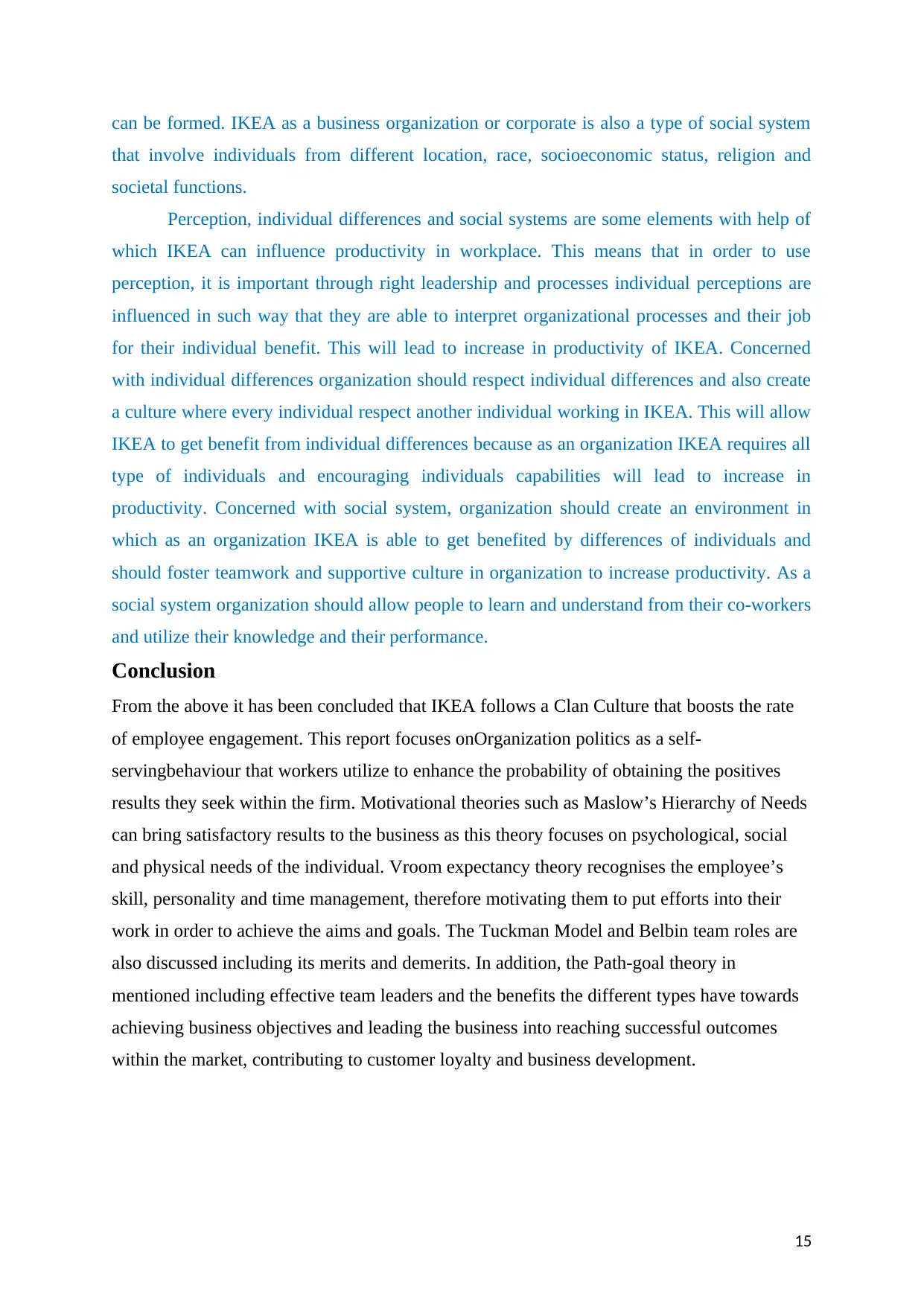
can be formed. IKEA as a business organization or corporate is also a type of social system
that involve individuals from different location, race, socioeconomic status, religion and
societal functions.
Perception, individual differences and social systems are some elements with help of
which IKEA can influence productivity in workplace. This means that in order to use
perception, it is important through right leadership and processes individual perceptions are
influenced in such way that they are able to interpret organizational processes and their job
for their individual benefit. This will lead to increase in productivity of IKEA. Concerned
with individual differences organization should respect individual differences and also create
a culture where every individual respect another individual working in IKEA. This will allow
IKEA to get benefit from individual differences because as an organization IKEA requires all
type of individuals and encouraging individuals capabilities will lead to increase in
productivity. Concerned with social system, organization should create an environment in
which as an organization IKEA is able to get benefited by differences of individuals and
should foster teamwork and supportive culture in organization to increase productivity. As a
social system organization should allow people to learn and understand from their co-workers
and utilize their knowledge and their performance.
Conclusion
From the above it has been concluded that IKEA follows a Clan Culture that boosts the rate
of employee engagement. This report focuses onOrganization politics as a self-
servingbehaviour that workers utilize to enhance the probability of obtaining the positives
results they seek within the firm. Motivational theories such as Maslow’s Hierarchy of Needs
can bring satisfactory results to the business as this theory focuses on psychological, social
and physical needs of the individual. Vroom expectancy theory recognises the employee’s
skill, personality and time management, therefore motivating them to put efforts into their
work in order to achieve the aims and goals. The Tuckman Model and Belbin team roles are
also discussed including its merits and demerits. In addition, the Path-goal theory in
mentioned including effective team leaders and the benefits the different types have towards
achieving business objectives and leading the business into reaching successful outcomes
within the market, contributing to customer loyalty and business development.
15
that involve individuals from different location, race, socioeconomic status, religion and
societal functions.
Perception, individual differences and social systems are some elements with help of
which IKEA can influence productivity in workplace. This means that in order to use
perception, it is important through right leadership and processes individual perceptions are
influenced in such way that they are able to interpret organizational processes and their job
for their individual benefit. This will lead to increase in productivity of IKEA. Concerned
with individual differences organization should respect individual differences and also create
a culture where every individual respect another individual working in IKEA. This will allow
IKEA to get benefit from individual differences because as an organization IKEA requires all
type of individuals and encouraging individuals capabilities will lead to increase in
productivity. Concerned with social system, organization should create an environment in
which as an organization IKEA is able to get benefited by differences of individuals and
should foster teamwork and supportive culture in organization to increase productivity. As a
social system organization should allow people to learn and understand from their co-workers
and utilize their knowledge and their performance.
Conclusion
From the above it has been concluded that IKEA follows a Clan Culture that boosts the rate
of employee engagement. This report focuses onOrganization politics as a self-
servingbehaviour that workers utilize to enhance the probability of obtaining the positives
results they seek within the firm. Motivational theories such as Maslow’s Hierarchy of Needs
can bring satisfactory results to the business as this theory focuses on psychological, social
and physical needs of the individual. Vroom expectancy theory recognises the employee’s
skill, personality and time management, therefore motivating them to put efforts into their
work in order to achieve the aims and goals. The Tuckman Model and Belbin team roles are
also discussed including its merits and demerits. In addition, the Path-goal theory in
mentioned including effective team leaders and the benefits the different types have towards
achieving business objectives and leading the business into reaching successful outcomes
within the market, contributing to customer loyalty and business development.
15
Secure Best Marks with AI Grader
Need help grading? Try our AI Grader for instant feedback on your assignments.
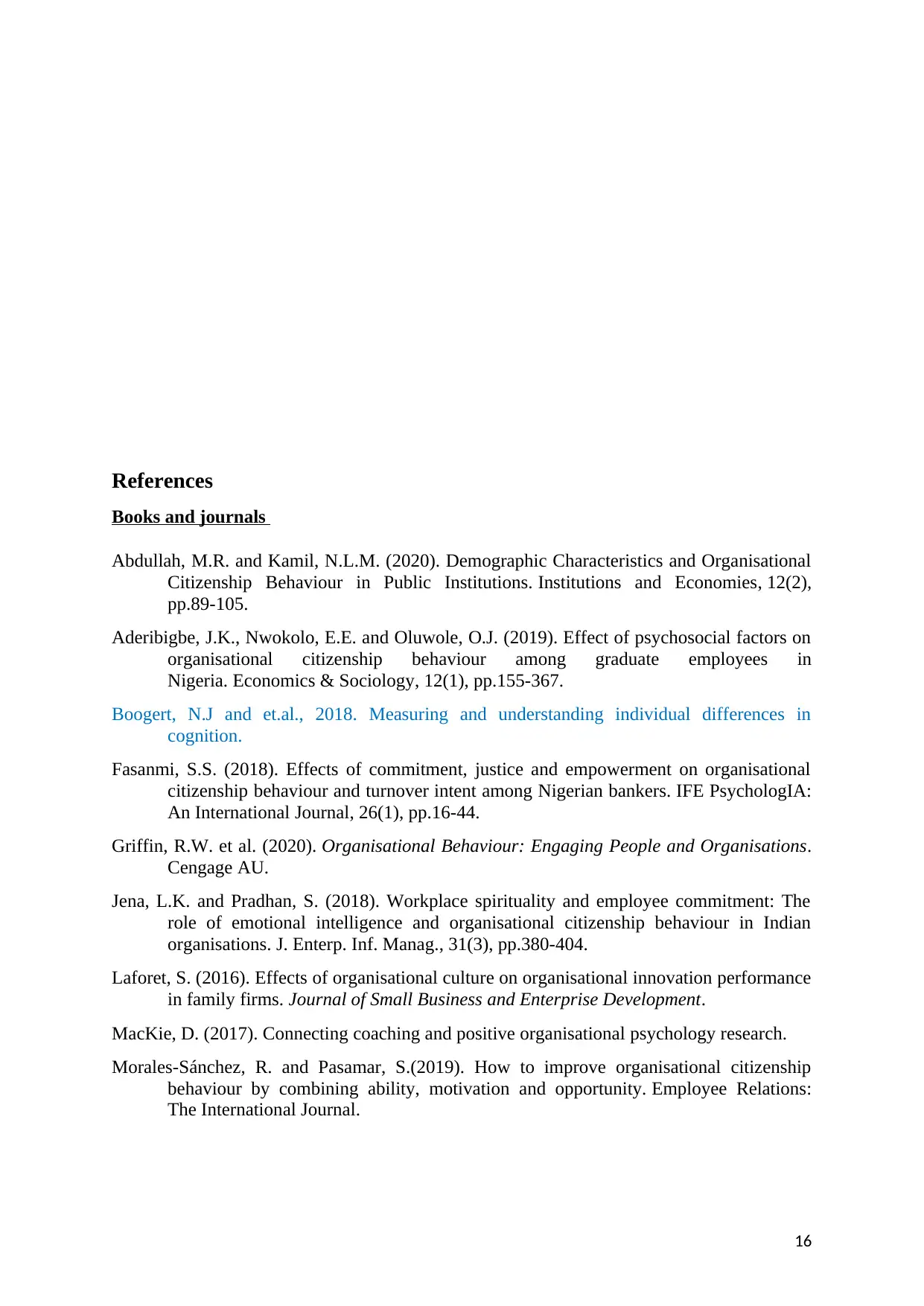
References
Books and journals
Abdullah, M.R. and Kamil, N.L.M. (2020). Demographic Characteristics and Organisational
Citizenship Behaviour in Public Institutions. Institutions and Economies, 12(2),
pp.89-105.
Aderibigbe, J.K., Nwokolo, E.E. and Oluwole, O.J. (2019). Effect of psychosocial factors on
organisational citizenship behaviour among graduate employees in
Nigeria. Economics & Sociology, 12(1), pp.155-367.
Boogert, N.J and et.al., 2018. Measuring and understanding individual differences in
cognition.
Fasanmi, S.S. (2018). Effects of commitment, justice and empowerment on organisational
citizenship behaviour and turnover intent among Nigerian bankers. IFE PsychologIA:
An International Journal, 26(1), pp.16-44.
Griffin, R.W. et al. (2020). Organisational Behaviour: Engaging People and Organisations.
Cengage AU.
Jena, L.K. and Pradhan, S. (2018). Workplace spirituality and employee commitment: The
role of emotional intelligence and organisational citizenship behaviour in Indian
organisations. J. Enterp. Inf. Manag., 31(3), pp.380-404.
Laforet, S. (2016). Effects of organisational culture on organisational innovation performance
in family firms. Journal of Small Business and Enterprise Development.
MacKie, D. (2017). Connecting coaching and positive organisational psychology research.
Morales-Sánchez, R. and Pasamar, S.(2019). How to improve organisational citizenship
behaviour by combining ability, motivation and opportunity. Employee Relations:
The International Journal.
16
Books and journals
Abdullah, M.R. and Kamil, N.L.M. (2020). Demographic Characteristics and Organisational
Citizenship Behaviour in Public Institutions. Institutions and Economies, 12(2),
pp.89-105.
Aderibigbe, J.K., Nwokolo, E.E. and Oluwole, O.J. (2019). Effect of psychosocial factors on
organisational citizenship behaviour among graduate employees in
Nigeria. Economics & Sociology, 12(1), pp.155-367.
Boogert, N.J and et.al., 2018. Measuring and understanding individual differences in
cognition.
Fasanmi, S.S. (2018). Effects of commitment, justice and empowerment on organisational
citizenship behaviour and turnover intent among Nigerian bankers. IFE PsychologIA:
An International Journal, 26(1), pp.16-44.
Griffin, R.W. et al. (2020). Organisational Behaviour: Engaging People and Organisations.
Cengage AU.
Jena, L.K. and Pradhan, S. (2018). Workplace spirituality and employee commitment: The
role of emotional intelligence and organisational citizenship behaviour in Indian
organisations. J. Enterp. Inf. Manag., 31(3), pp.380-404.
Laforet, S. (2016). Effects of organisational culture on organisational innovation performance
in family firms. Journal of Small Business and Enterprise Development.
MacKie, D. (2017). Connecting coaching and positive organisational psychology research.
Morales-Sánchez, R. and Pasamar, S.(2019). How to improve organisational citizenship
behaviour by combining ability, motivation and opportunity. Employee Relations:
The International Journal.
16
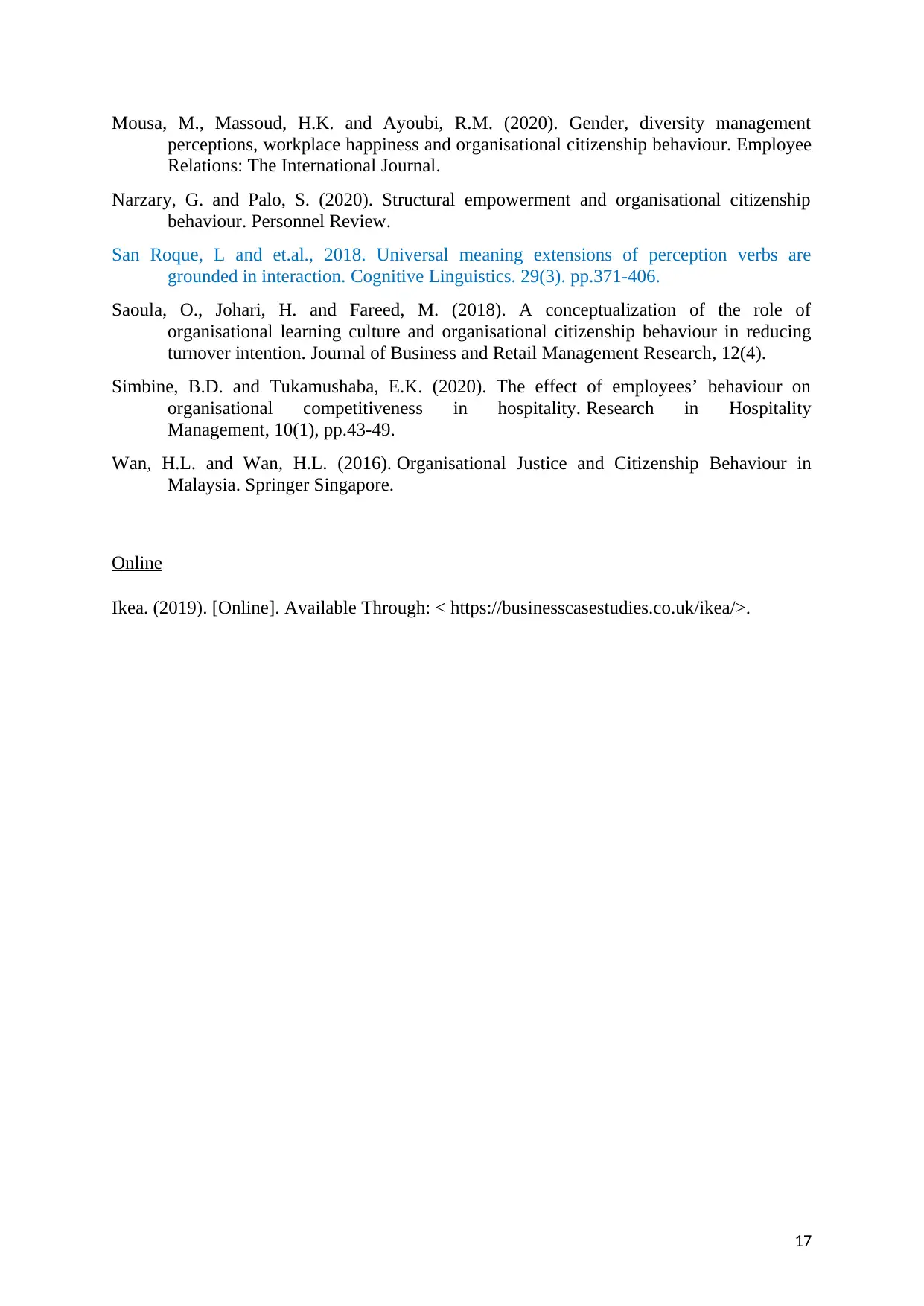
Mousa, M., Massoud, H.K. and Ayoubi, R.M. (2020). Gender, diversity management
perceptions, workplace happiness and organisational citizenship behaviour. Employee
Relations: The International Journal.
Narzary, G. and Palo, S. (2020). Structural empowerment and organisational citizenship
behaviour. Personnel Review.
San Roque, L and et.al., 2018. Universal meaning extensions of perception verbs are
grounded in interaction. Cognitive Linguistics. 29(3). pp.371-406.
Saoula, O., Johari, H. and Fareed, M. (2018). A conceptualization of the role of
organisational learning culture and organisational citizenship behaviour in reducing
turnover intention. Journal of Business and Retail Management Research, 12(4).
Simbine, B.D. and Tukamushaba, E.K. (2020). The effect of employees’ behaviour on
organisational competitiveness in hospitality. Research in Hospitality
Management, 10(1), pp.43-49.
Wan, H.L. and Wan, H.L. (2016). Organisational Justice and Citizenship Behaviour in
Malaysia. Springer Singapore.
Online
Ikea. (2019). [Online]. Available Through: < https://businesscasestudies.co.uk/ikea/>.
17
perceptions, workplace happiness and organisational citizenship behaviour. Employee
Relations: The International Journal.
Narzary, G. and Palo, S. (2020). Structural empowerment and organisational citizenship
behaviour. Personnel Review.
San Roque, L and et.al., 2018. Universal meaning extensions of perception verbs are
grounded in interaction. Cognitive Linguistics. 29(3). pp.371-406.
Saoula, O., Johari, H. and Fareed, M. (2018). A conceptualization of the role of
organisational learning culture and organisational citizenship behaviour in reducing
turnover intention. Journal of Business and Retail Management Research, 12(4).
Simbine, B.D. and Tukamushaba, E.K. (2020). The effect of employees’ behaviour on
organisational competitiveness in hospitality. Research in Hospitality
Management, 10(1), pp.43-49.
Wan, H.L. and Wan, H.L. (2016). Organisational Justice and Citizenship Behaviour in
Malaysia. Springer Singapore.
Online
Ikea. (2019). [Online]. Available Through: < https://businesscasestudies.co.uk/ikea/>.
17

18
1 out of 19
Related Documents
Your All-in-One AI-Powered Toolkit for Academic Success.
+13062052269
info@desklib.com
Available 24*7 on WhatsApp / Email
![[object Object]](/_next/static/media/star-bottom.7253800d.svg)
Unlock your academic potential
© 2024 | Zucol Services PVT LTD | All rights reserved.





